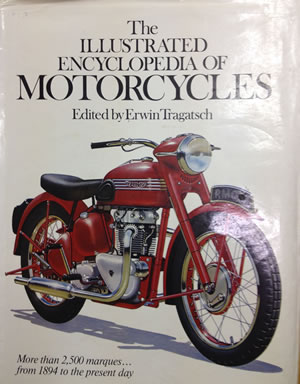

I have acquired the remains of a London built motorcycle (it converts to a Fore-car) made by The Ascot Motor Co.
When I started my research almost nothing was known about Ascots, the "Bible" - Tragatsch had just 11 words to say and research suggests that none of it is correct.


Ascot started making motorcycles sometime between the summer of 1901 and early 1902 and seemingly ceased trading in late 1904 or early 1905 as that is the last I can find of them.
The founder of the company Percy Herbert Cecil Sandham was listed as a cycle maker from 1899 to 1901 so seems to have been one of the early cycle makers to experiment with motorcycles. After Ascot had ceased around 1905, he went back to cycles as he is listed as a cycle maker again in 1906.
In later life he patents numerous motorcycle related items so his interest in motorcycles seems to have continued after Ascot.
He started Sandham Engineering of 336 Gray's Inn Road and made the Sandum sidecar, cycle sidecar and sidecar hoods and screens - this business ran until the 1930's and probably into the 50's. He was probably the main supplier of sidecars to the AA and in 1919 claimed to have made 10,000 sidecars. I have not yet a picture of Percy but I do have his signature from
his will in 1948 when he died.
At the time he was living by the sea overlooking a Golf course, so seemingly happily retired.

In 1906 The MotorCycle had a multipage article listing every make and type of motorcycle on the market and as Ascot is not listed so they must have ceased trading by 1906.
Ascot started making motorcycles of 2¾ hp 80x80 (402cc) and 3½ hp (400-500cc). They also made Tri-cars (2 wheels at front, 1 at back) and Fore-cars with a seat at the front.
So when did Ascot start and stop?
The 1899 edition of Kellys Directory (a period listing of Business and people - like the Yellow Pages) lists Percy Herbert Sandham & Co "bicycle manufacturer" at 187 Grays Inn Road.
The 1901 Electoral register has Percy at 187 Grays Inn Road and the 1901 Census lists him as "Cycle Manufacturer and Employer" - so as he is now listed also as an employer, I assume his business has grown.
The 1902 Electoral register lists him at 187 Grays Inn Road.
The 1903 edition of Kellys Directory lists The Ascot Motor Company, 212 Pentonville Road, N., from 1903 until 1905. This Directory was researched and created in the September/October for publication in December and January of the following year. Accordingly Ascot must have been in Business by September 1902 for it to be included in the 1903 Directory. As the 1901 Electoral register was created in March 1901, it follows that sometime between March 1901 and September 1902 that The Ascot Motor Co started. I may be able to narrow this down with further research and for now I assume they started late 1901/early 1902.
They must have been in business in September 1904 to be included in the 1905 Directory. As they are featured in Peaches 1905 Annual and that was created around November/December 1904 - I think it is safe to assume that Ascot was still in business in November 1904. This would seem to be supported by Ascots last mentions in the press in November 1904.
The Electoral Rolls from 1906 to 1909 list Percy back at 187 Grays Inn Road. From other research I suspect that his cycle business continued at 187 whilst his Ascot business ran at Pentonville Road.
Pentonville Road and Grays Inn Road are just a few minutes' walk apart and in the era were in the centre of the automotive world in London.
The area was thick with other companies making and selling cars, motorcycles and parts - it would have been the premium place to have such a business.
In the 1901 to 1905 era the early motorcycle industry boomed
as seemingly almost every cycle maker had a go at adding an engine to a sturdy
cycle frame. The majority of them had little idea about the new world of petrol
engines and the glut of inexperienced makers and less than ideal machines caused
the fledgling motorcycle industry to stall. Supply exceeded demand and consumer
confidence rapidly faded as they became the guinea pigs for hundreds of
inexperienced makers who had usually made lavish claims.
In this situation is not surprising that Ascot failed - which is a shame as
Ascot were very advanced for the era - perhaps too advanced for a conservative
Edwardian customer.
The Ascot engine
When I started researching Ascot almost nothing was known about them. After exhausting all of the period magazines I started to take a wider view on research. From what I had gleaned I started to come up with educated assumptions and then try and prove or disprove my theory. This approach has led to some interesting discoveries that point at the likely history of Ascot. I will probably never be 100% certain, but when many elements combine, it does point to a likely scenario.
I have searched high and low for a similar method to how Ascot activated its valves and finally have a very good match – see below.
On the left we have Ascot's design and on the right is Holden's.
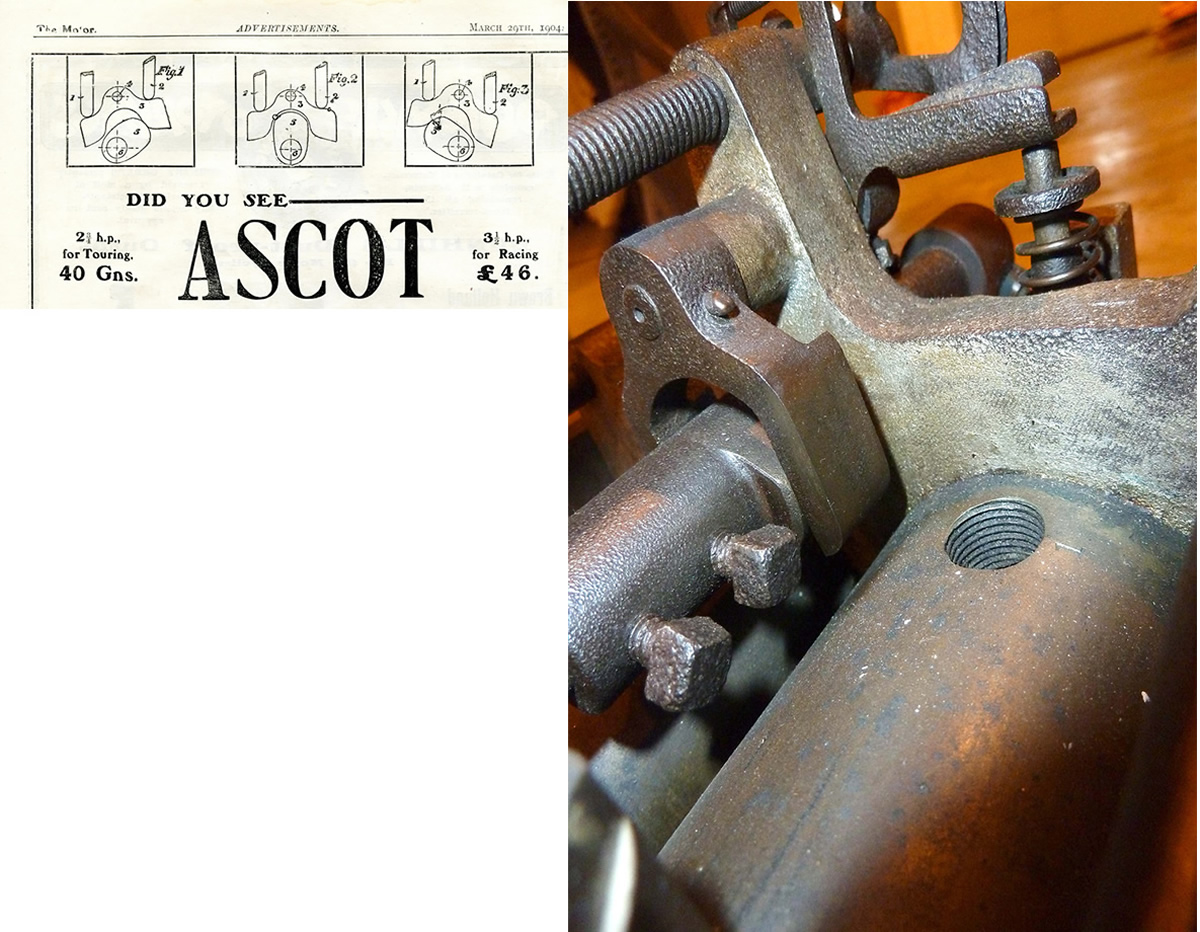
It is from the Holden (1896-1902). It has the same single cam rocking a horseshoe shape to operate two valves. The patent for this cam resided with Col Holden (of Brooklands fame) and I suspect he either licenced the design to Ascot or was not amused by Ascot’s use of it. I have searched 3,800 patents to see if Ascot had its own patent and can find no sign of it.
Below is a the drawing from Holdens 1896 Patent showing again the cam inside a horseshoe type mechanism.
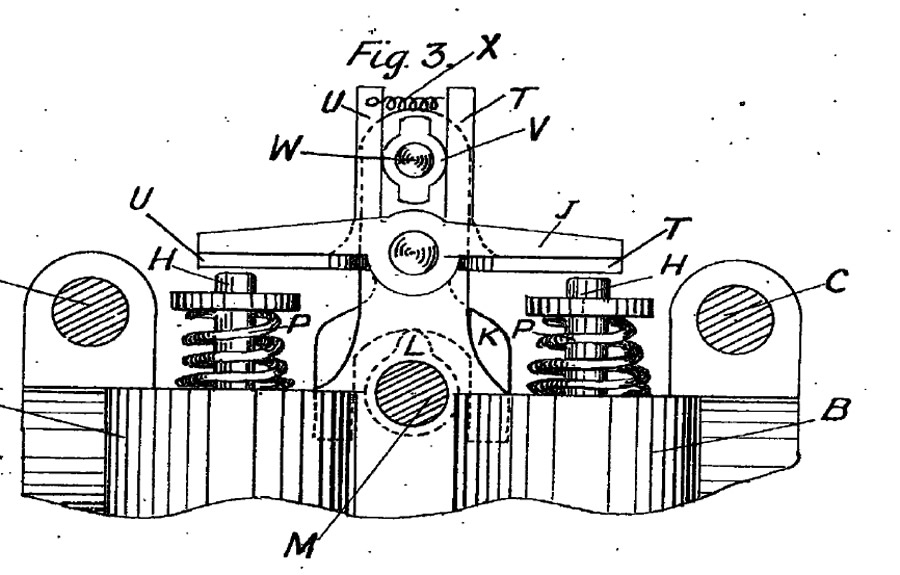
Further, The English Mechanic magazine (I now have electronic editions from 1898-1908) ran a 16 part article from Jan 1901 on how to build a motorcycle with fully dimensioned engineering drawings. Many of the dimensions are an exact match for the Ascot – though the design is for an atmospheric inlet engine. So my current thinking is that Percy Sandham took the basic design from English Mechanic and copied/added the cam design from the Holden to create the first Ascot. The final part of the series was published in the spring of 1901 and so perhaps Percy's ideas/designs started at this point. It would fit in with the likely start of The Ascot Motor Co. The author of the articles complained in 1904 that many people had copied his design. My engine is made in imperial measures as per the English Mechanic.
My Ascot engine is very narrow and hence fits with the very early design of motors where the crankcase width had to fit with the narrow gap between a bicycles pedal throw.
Further pointers to the engine being early are the period references to De Dion parts compatibility. In the 1904 Show guide Ascot advert they refer to “All valves springs and piston rings interchangeable with De Dion” and list the engine as 80x80. If Ascot were using a complete De Dion engine they would have said - as it was a respected make and they would have gained from saying so. What their advert implies is that their engine used some De Dion parts and hence is derived in part from De Dion. I have searched widely for 80x80 engines with any De Dion connection and in November 1899 De Dion announce an 80x80 engine so we seem to have a match. This information comes from Herbert Osbaldeston Duncan and his 1926 book - "The World of Wheels True tales of the cycle & motor industries". Herbert had been a Director of De Dion Bouton from 1898 so he would have a clear and accurate view.
I should thank Mr R Bird for his sharing his very considerable knowledge of the early years of the industry with me, as this has greatly assisted my research and contributed a huge amount to my research.
I have found no evidence to suggest (either way) that Percy Sandham had the skills to actually make an Ascot engine. His father was a piano maker, so we can assume he would have grown up trained in the use of hand tools and precision with wood and metal - you cannot make a piano without these skills. We know that in 1899 Percy is listed as a bicycle manufacturer so I have no doubt he could have made a frame, built wheels and everything but the engine. Maybe I am doing him a disservice by assuming he could not have made the engine himself, but in 1901 only a very few people had any practical experience of the metallurgy and engineering skills to cast crankcases and machine cranks, pistons etc. You would need many years experience to make an engine and my Ascot engine is very finely made - it is the product of a very skilled/experienced engineer and not a beginner.
This then leads me to explore who could have made engines based upon De Dion parts for Percy Sandham and Ascot.
The 1904 Chater Lea catalogue (created late 1903) lists an 80x80 engine from MMC that has a Mechanically Operated Inlet Valve (MOIV), but sadly doesn't picture it.
Further research suggests that the 80x80 MMC engine was like a De Dion with an
engine with external bolts from head to crankcase - so not the Ascot engine.
MMC is the Motor Manufacturing Company, Limited,. This company was founded in January 1898 from the failed Great Horseless Carriage Company - one of Harry Lawson's earlier ventures.
They used De Dion designs to make cars and motorcycles and sell engines and parts to others. They were a large maker at the time, but by summer 1904 had gone bust.
Accordingly MMC is a possible supplier of the early Ascot engine, but unlikely. Lawson organised the first London to Brighton "Emancipation Run" to celebrate the relaxation of the Red Flag Act and start of the development of the British motor industry. Lawson attempted to monopolise the British motor industry by acquiring key patents such as the exclusive British rights to manufacture the De Dion-Bouton.
Another contender for building my Ascot engine is MCC (Motor Castings Co) of 101 Gray's Inn Road - so another close neighbour of Percy's. If you were today choosing someone to make you an engine you would want someone local, with proven ability and ideally someone you have known for a while and hence trust. MCC was founded and run by Charles Herbert Erskine Rush, born in 1873 and was apprenticed to LBSCR at Brighton at the same time as Harry Collier snr. which makes a most interesting connection. He moved to Daimler Motor Co in London and then joined the British Motor Company and the London Autocar Co all in the same year 1898. London Autocar Co was based at 182 Grays Inn road and he was there until at least mid 1902 as manager. At this time Percy was in business at 187 Gray's Inn Road so as neighbours they must have known each other from this time on. The BMC connection would have brought Mr Rush into close relationship with MMC as George Iden was works manager and he had served his apprenticeship under him at Brighton. The advert from July 1903 shows that MCC were capable of producing a complete machine at this time.
.jpg)
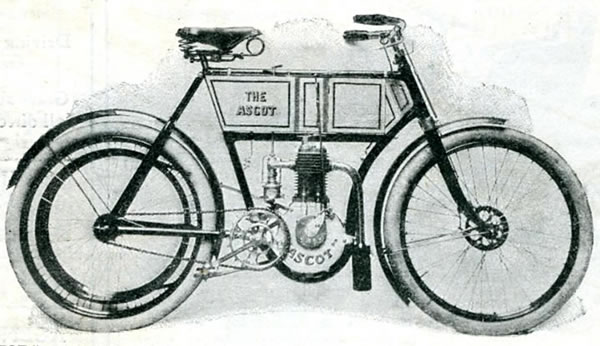
Whilst this advert dates from July 1903, I do not know how long before this they had the capability to sell/make engines and complete motorcycles.
It is certainly similar to the March 1904 Ascot on the right.
A year later MCC were offering a complete range components from engines to frames including hubs to allow dabblers to go into production on a small scale - again they may have been doing this for some time before this advert.
.jpg)
MCC were selling "De Dion type motors" so seem a good match for making the Ascot engine as they were on Ascots doorstep, Percy must have known him for several years and he evidently had the ability to make such an engine. Sadly in May 1905 The London Gazette reports that MCC has failed as a business and is being wound up. So the MCC company existed in the era that my Ascot was probably made and are another strong contender for building the engine.
Another contender for the making the engine is The London Autocar Co of 182 Grays Inn Road. They were at 182 in May 1899 (the earliest I can find - but seem well established at this point) and as Kellys lists Percy at 187 Grays Inn Road in 1899 - he must have known them. They sold De Dion engines, components and converted engines to the latest specs. They supplied engines and components to the trade. They had fizzled out and The London Gazette of February 12th 1907 reported them being closed and wound up.

And a further contender for casting the engine is also nearby and less than a mile away at 15 Myddelton Street is RW Coan. They would cast you an engine from your pattern same day!
Their advert below is from Motor Cycling of 26th November 1902.
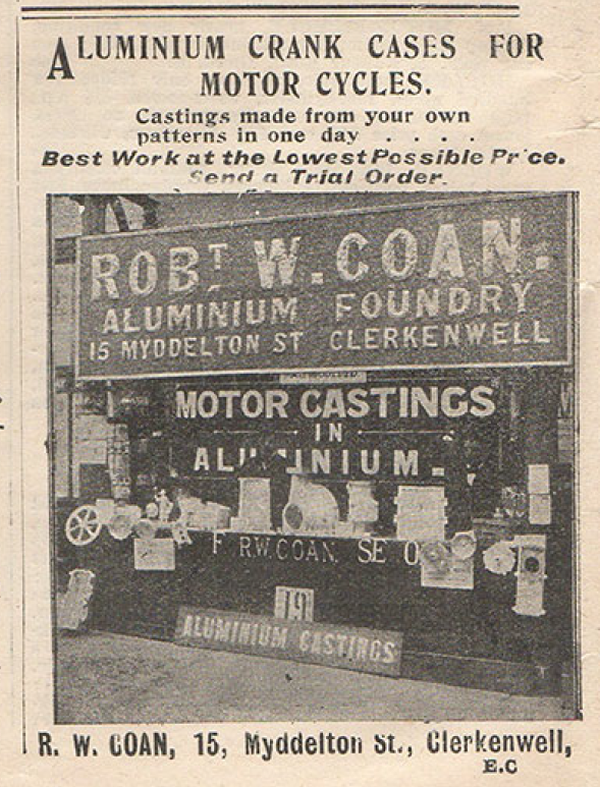
The Ascots featured in the 1904 adverts are attached to the loop frame via a "swan neck" type crankcase casting. Motorcycles of 1900 era usually simply clamped an engine to the front diagonal tube of a heavy bicycle frame (often called the Minerva position) and hence the engine was angled/inclined to match the frame. By 1900/01 people were building bespoke motorcycle frames and putting the engines in numerous places - many quite odd - above the handlebars! as an example. The ideal place we now know is low down, to lower the centre of gravity and clamping the engine to the frame seemed the ideal and many set off down this path. However from summer (ish) 1902 to early 1904 we see a great flurry of engines mounted low down, but not attached thus - but by alternative means such as Swan Neck castings. The reason for this, it would appear is that Werner had a Patent on bolting an engine into a cradle at the bottom of the frame and started suing everyone who infringed upon it. They had certainly started legal actions from August 1902 and hence many makers in the late 1902 to early 1904 period came up with designs to avoid a clash with Werner's legal team.
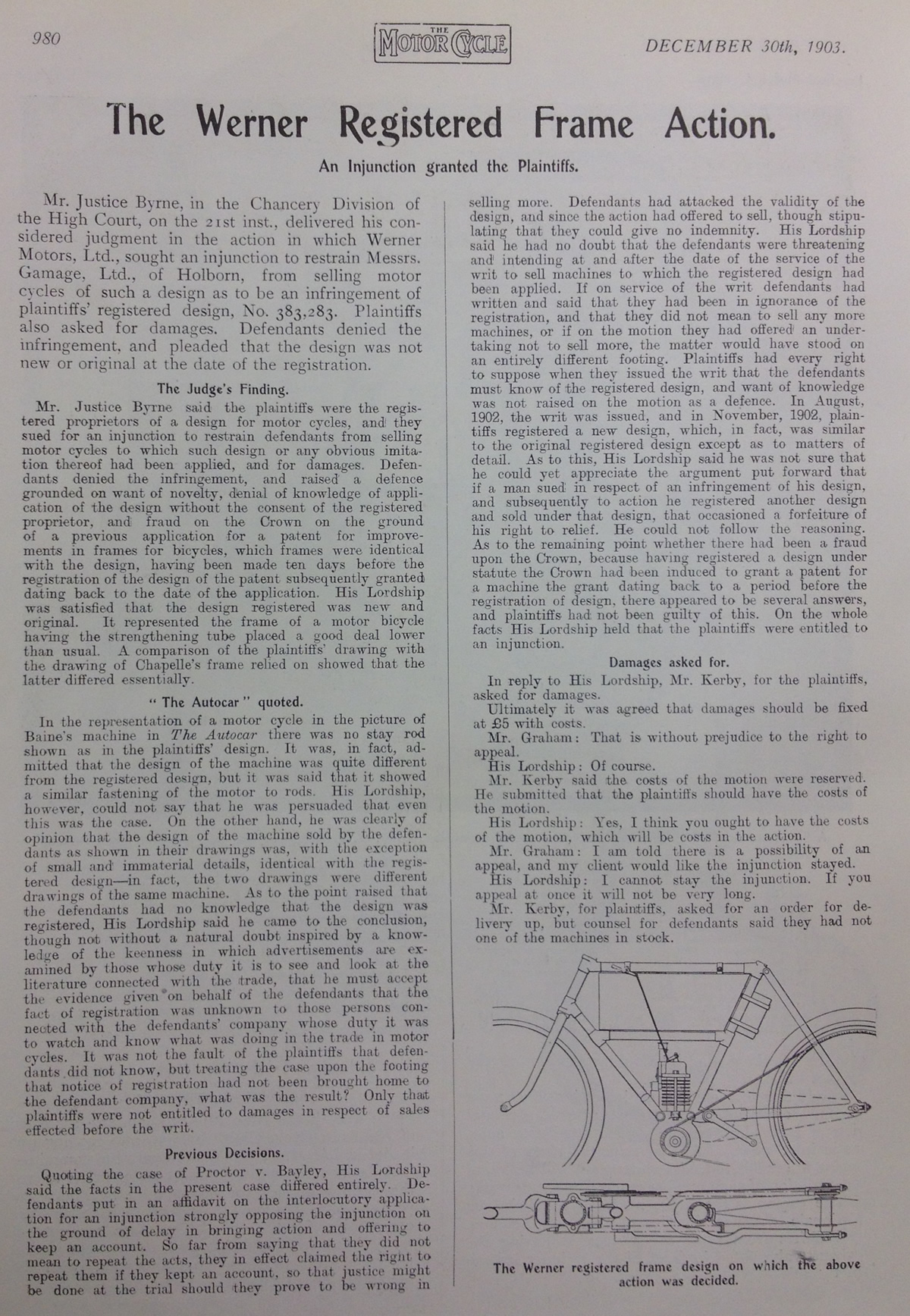
Later in 1904 Werner's legal case seems to have weakened and the industry returned to cradle frames and that's how engines are fitted still a century later. Therefore I think my "cradle" style engine would have been prior to the Werner litigation era (summer 1903 to summer 1904) and that Ascots 1904 Swan Neck engines were perhaps a reaction to Werner's legal activities. By autumn 1904 Ascot seem to be making cradle style frames holding their "new " 3hp engine.
The Ascots featured in the March 1904 onwards adverts appear similar to The Kerry, but with the Ascot valve gear in use. Period second-hand adverts refer to Ascots as Ascot Kerry’s which would seem to show that in the era people thought/knew that the bike was an Ascot with a Kerry engine. Kerry's of 1902-4 are fitted with Sarolea engines and look much like the same era Sarolea and would have been metric. As my engine is imperial, it is not of the "Kerry/Sarolea" era as they would have been metric.
The earliest mentions of Ascot is the London Show of March
1904.
The new model Ascots have "New design in levers" and "Exhaust valve
Lift of new design" so there were Ascot's prior to this that they have been
improved upon.
The exhaust valve lifter (decompressor) on my engine is very basic - and does
not resemble the one pictures in 1904 - so I suspect my engine has the earlier -
inferior! mechanism.
My thinking so far is that Ascot started with its own engine made in London in c1901/2 based upon the English Mechanic and Holden designs. By March 1904 they were either using a Kerry/Sarolea engine or having one made that looked very similar - so similar that a year or two later dealers referred to them as Ascot Kerry's.
The MotorCycle of November 21st 1904 refers to Ascot's showing only a 3hp and 3½ hp motorcycles and one of these (the new 3hp model) is fitted in a new "long wheelbase" frame.
I think this will have been a Chater Lea frame No 6 frame with spring forks. At this time they still seem to have the existing 3½ hp machine in the high loop frame.
Bicycling News, 1904 November 23rd, page 17 says that Ascot are using "a foreign engine with a steel crankcase" and is "very low built". The very low built comment refers to the No6 frame and the other reference would seem to show that Ascot have used a new engine from another "foreign" manufacturer and that the crankcases are made of steel . Steel crankcases were very unusual and I am not sure who may have made such an engine. Percy may have moved to consider steel crankcases as many Swan neck alloy engines of the era (of Kerry etc.) were known to crack and fail as the design is not an ideal way to attach an engine.
I can find no mention of an 80x80 engine in a cradle frame in the March 1904 - November 1904 period and with all other research considered further conclude that my engine was made earlier as Ascot seems to expire as a business shortly after November 1904.
Also mentioned in November 1904 is that they are selling the tiny 1hp Herdtle & Bruneau machine.
So in summary, my current theory is that my engine is c1901-03 and made in London.
The early 1904 engines look similar to the Kerry. The Kerry was a rebadged
Sarolea.
By the end of 1904 they were using a "foreign made" engine of as yet unknown make with steel crankcases.
Ascot seem to have used Chater Lea frames (or certainly made frames using CL lugs/designs) for some of the time they were in business and perhaps all of the time.
During my research I did wonder if the c1904 Ascot engines
were Kerry/Sarolea
"swan necks" as they do look similar.
I took the Ascot engine and overlaid it upon
a 1902/3 Kerry engine.
As you can see below they are not a match and the swan neck is not in the same
place or the front mounting point.
So a No vote for Kerry/Sarolea based engine cases being used by Ascot.
If the cases were Kerry/Sarolea they surely would have left the swan
neck/mounting lugs in the same place on the crank case.
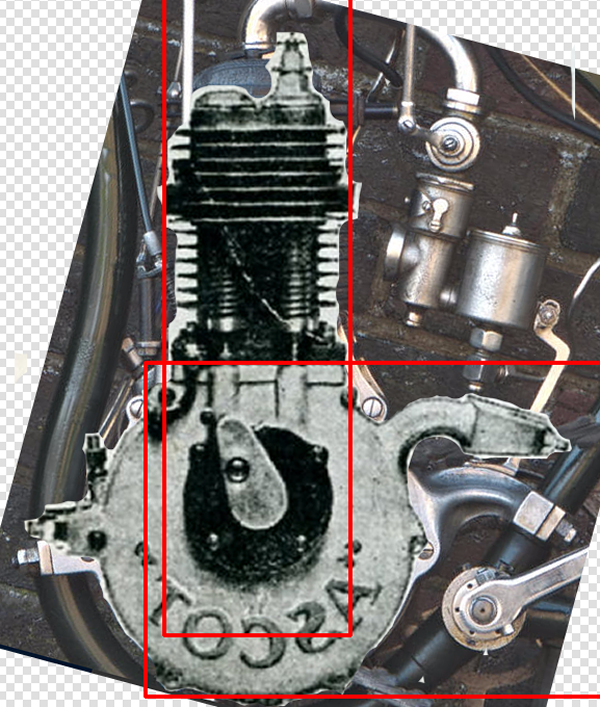
I am doing research to find out all I can about this company and its machines. Its most innovative feature is that it operated both valves mechanically via a normal cam and a rocking saddle mechanism. The majority of engines of this era only drove the exhaust valve mechanically and allowed atmospheric pressure to open the inlet valve. In its day the Ascot was described as "very fast", probably due to the innovative engine. The distance between the carb and engine was quite short which would have enhanced performance as other period designs had a very long intake between carb and engine and this caused icing and detracted from performance. The short intake, mechanically operated valves and straight inlet into the engine would have all enhanced performance over other period engines. Information about Ascot's is scarce.
You can see pictures of the engine as it was discovered, being taken apart and now rebuilt- here
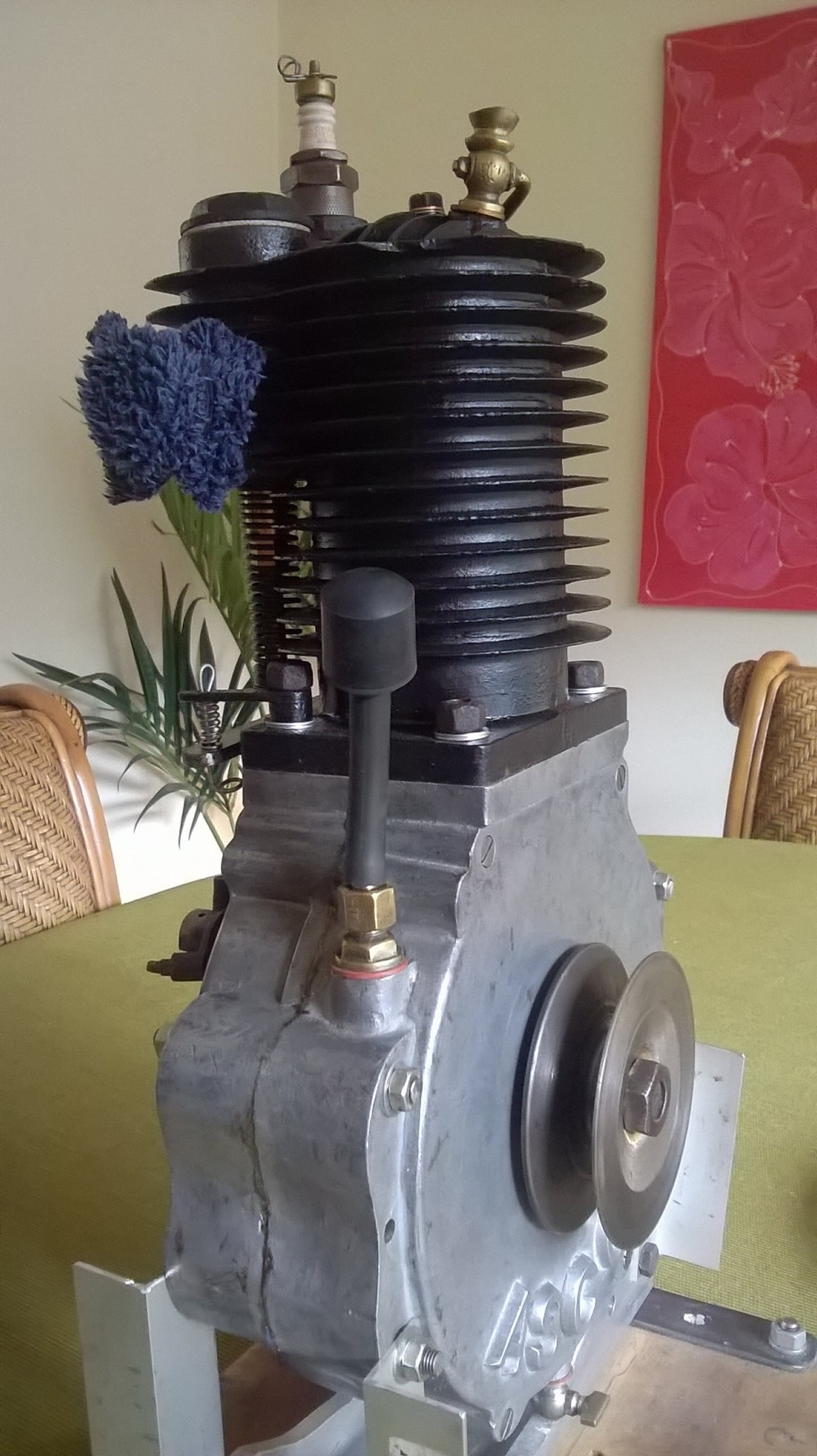
I consulted the standard reference books and they said that Ascot used Antione, Minerva and Kelecom engines. Perhaps the main reference work is Tragatsch, below.


I have sent details and pictures of my engine to the experts on Antoine, Minerva and Kelecom and they tell me my engine is not made by them. The more research I do, the less the period reference seem to be proven to be correct. Not surprising as when the great references works were created they gathered info on a thousand plus makes and errors were bound to creep in - I suspect I am the first and only person to conduct detailed research on Ascot's.
As my engine is 80mm stroke x 80mm bore it is 402cc. The table below gives the period conversion from cc to period HP.
I did wonder if my engine of 402cc could be seen as close to 400cc and hence rated 3hp, but I have found other makes who in period had similar cc and rated the bike at 3.5hp - the 80x80 (402cc) 3.5hp NSU being an example. Further research showed that Ascot rated its 80x80 engine of 402cc as a 2¾ hp engine so they were being very conservative in the hp they rated/claimed.
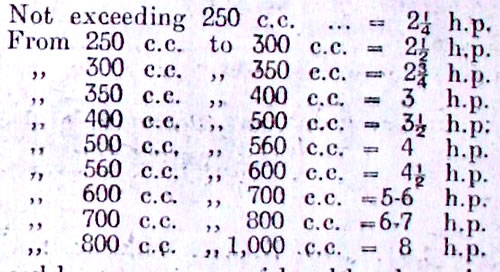
I think my engine is one of Ascots own.
The Engine
When I first got the engine it took a long time to clean a century plus of grime from it. When I took it apart it was almost like new inside and I came to two conclusions. It had either been rebuilt at some point in its life and little used since or it was still as it left the factory in c1903 and hardly used since. I think I can answer this as when I took the engine apart the base gasket was card with coloured print on it. Further investigation revealed that this was from Cadbury's Cocoa Essence packaging (below). You know that you interest in old bikes is going too far when you start to try and date ancient gaskets! I have now been told that this type of branded packaging was made either in just c1900 or 1900-1903 - either way it would imply that when my engine was assembled at around the same time. Below is the gasket and a period picture of the whole card.

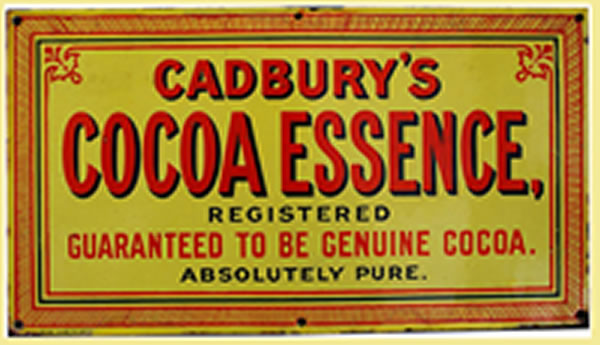
Summary of Research - December 2014 - some of the thoughts below have now been changed by further research, but I shall leave them for now.
Research would seem to indicate that Ascot engines from March 1904 with the swan neck alloy attachments to the frame were made by Sarolea and the crankcases were very similar/seemingly the same as the engine fitted to a Kerry. The Kerry motorcycle also used Sarolea engines. The Kerry was created by a London based business - The East London Rubber Company imported numerous foreign goods and had a large catalogue of all its wares, which by 1900 featured cycles under the Kerry brand. Mr Kerry was the MD and seemingly the driver for the move into cycles and in 1902 Kerry motorcycles. Kerry became the motorcycle brand of the East London Rubber Company and sold "Kerry" engines from 1903 (maybe before) to the trade and said that you could have your engine unnamed or "named sets" - ie with your name cast into the crankcase.
As Kerry were just a mile from Ascot, they could have got their engines from Kerry or direct from Sarolea.
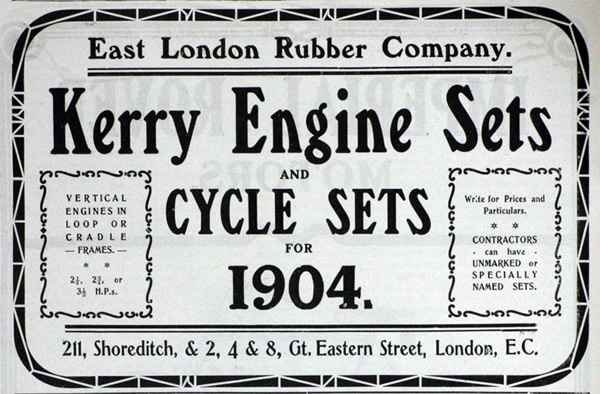
The above advert (from the Stanley Show of November 1903) also tells us that in addition to the swan neck style crankcases (for loop frames) they also made engines for cradle frames which would have been bolted into the frame and would not have had a swan neck casting - so just like my engine.
As Kerry and Ascot were seemingly built by the same company I have looked to see if the Kerry and Sarolea engines of 1902 to 1905 can be used to confirm when my engine was made - was it 1903 or 1904?
This lead me to research the early years of Sarolea, another make of which not much is known as their early archives are lost. Sarolea started making motorcycles in 1901 and were so good at it that they supplied engines to numerous other makers. Sarolea had an excellent understanding of metallurgy as they were a long established weapons manufacturer and this also gave them a head start in understanding how best to mass produce complex metal machines. Sometime around 1895 the son of the founder - Mathieu-Joseph Sarolea became interested in the emerging motors and especially the locally built De Dion & Bouton tricycles. The early Sarolea engines were supposidly designed by Martin Fagard who joined the company in c1895 and became its designer and later factory manager. I have found a 1901 patent showing that Emile Sarolea applied for a patent for a crank design that looks the same as a sectioned drawing of a 1904 Sarolea - so maybe he also designed them or took the credit for Martin's work - we may never know.
The Sarolea logo of pre 1904 is ![]() and they used the same font to cast their name into their big guns and their early engines.
and they used the same font to cast their name into their big guns and their early engines.
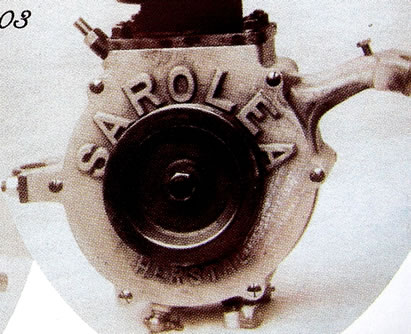
I think in the early years when someone wanted one of their engines with their own name cast in they just took out the letters required and cast crankcases to suit.
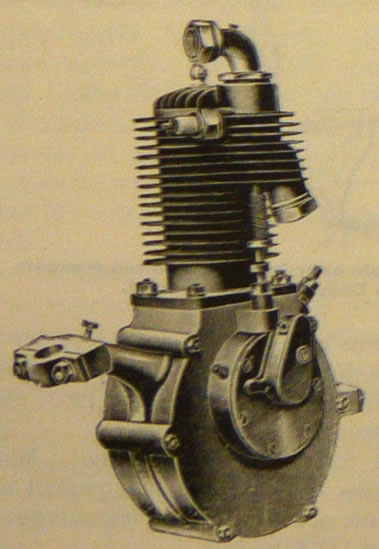
The engine below is a Sarolea built engine, branded for Kerry and dating from 1902 - as you can see it uses the same font.
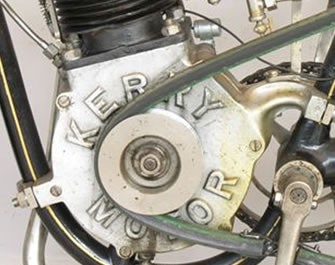
My Ascot engine uses the same font/lettering, see below
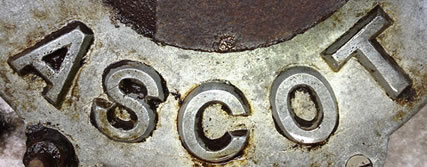
I think that around late 1903 or very early 1904 Sarolea changed from just using their own font to be able to cast other fonts and styles of lettering into the engines to suit customer demand.
By March 1904 they were casting ASCOT in the font that matched the style/font/logo requested, see below.
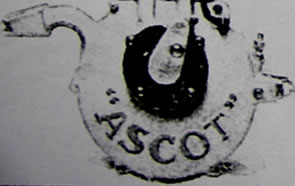
This change also seems to occured with Kerry engines in the same timeframe.
In later period secondhand adverts the Ascot is refered to as an Ascot/Kerry seemingly telling us that in the period people knew the engine was from Kerry as Sarloea also made the Kerry engine. It would seem that Sarolea had been making this type of swan neck crankcase design from around 1902 as a dated 1902 Kerry has this type of engine casting used. The swan neck design was an early solution for how to attach an engine to the early primitive looped frame designs. Sarolea seem to have used the same basic engine crankcase and then added either the swan neck casting, cradle casting (like my engine) or a cast bracket just on one side of the cases to allow the engine to be suspended under the frame downtube.
The Kerry of 1902-1904 were branded Sarloea's and seemingly identicle.
The 1902-1903 Sarolea's and Kerry's had the engine mounted at a slight angle as picture below shows - it is from November 1902.
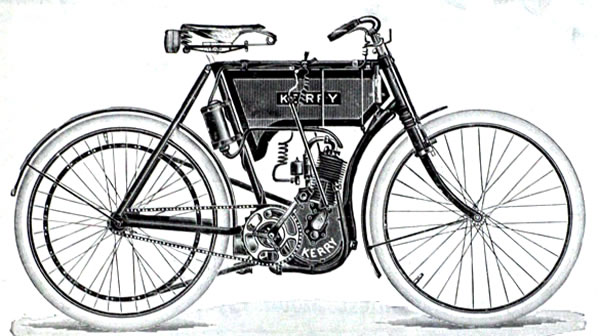
Sometime in 1903 (probably late summer) Sarolea moved to a vertical engine mount. The fashion was changing and vertical engines became the thing to have. Inclined engines came from the early years when engines were clamped to the front frame tube and therefore had to be inclined to fit with the run of the frame. As other ways of mounting engines developed the inclined engine continued as that what was being built and as new engines were built to suit new frames they moved to a vertical mounting. The period press of 1903 was full of praise for the new style of vertical engine and hence its favour grew.
Ascot were picturing the vertical engine from March 1904.
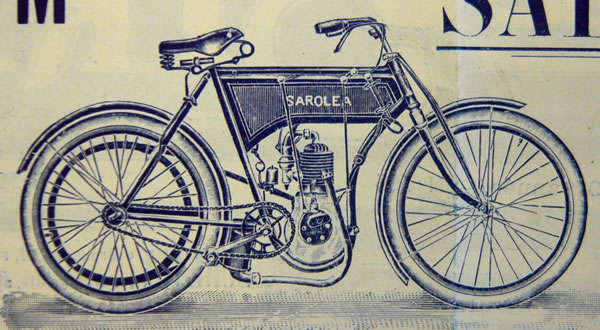
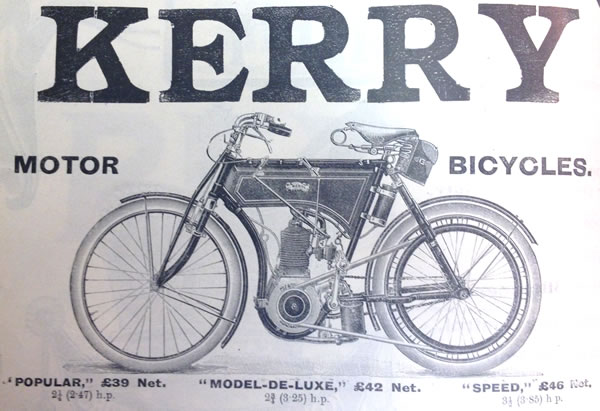
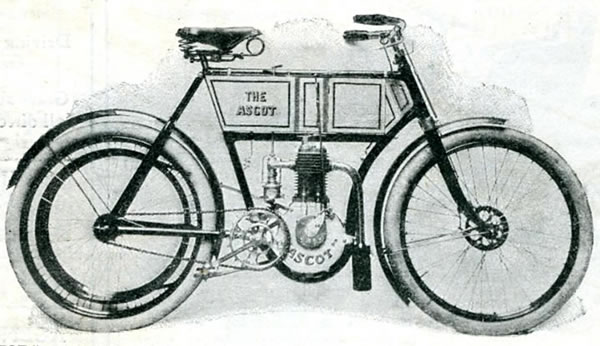 You can see that whilst the Sarolea and Kerry are the same, the Ascot is different in many areas such as frame, tank, front forks, front brake
You can see that whilst the Sarolea and Kerry are the same, the Ascot is different in many areas such as frame, tank, front forks, front brake
Later period secondhand adverts refer to Ascots also as Ascot Chater and Ascot ChaterLea indicating that in the period people knew that they used Chater Lea frames.
The cylinder of the Ascot engine in the period pictures is an exact match for my engine, so I expect the same cylinder would be used on swan neck and normal/cradle style crankcases.
You can see pictures of the engine as it was discovered and being taken apart - here
My current thinking is that the engines for Ascot may have been made by Sarolea, see the picture below. I am doing further research to try and find out.
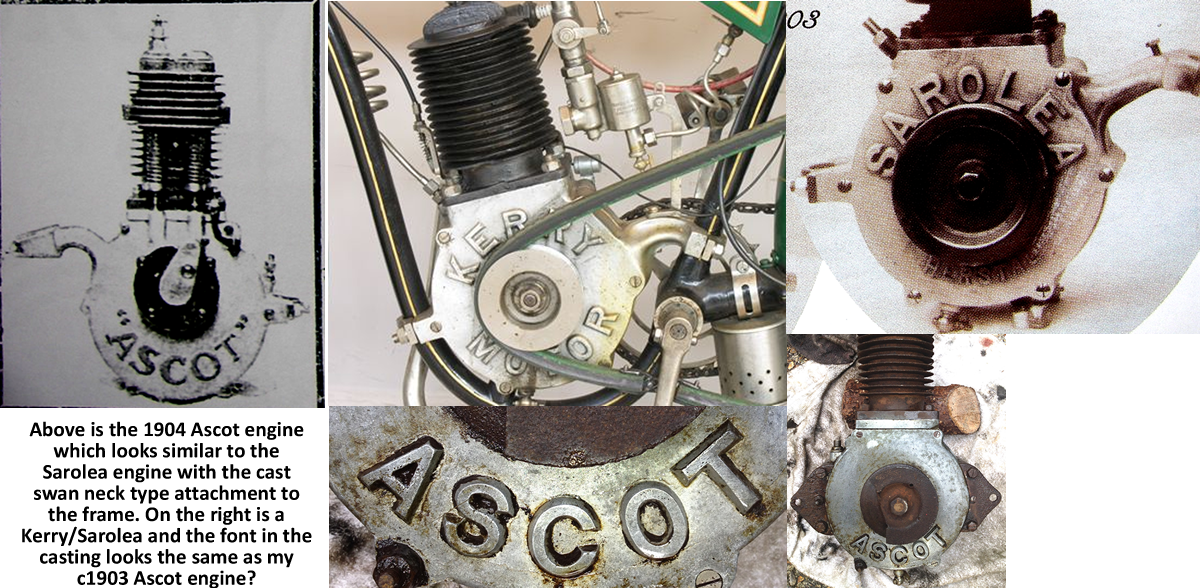
The History of Ascot Motor Co
In the early period of motoring most manufacturers used engines and components from someone else and created a machine from available existing parts. In 1903 Sarolea were one of the worlds largest and most successful engine makers and most UK brands used engines built in mainland Europe. Ascots like many early makers used other peoples frames (Chater Lea frames and fittings are mentioned in period secondhand adverts for Ascots) and in the couple of years they existed they seemed to have used two types of frame. I think the early frames were the higher style frames with loop bottoms and then I think they moved to the low frame pattern of a No6 Chater Lea frame from the end of 1904. In some period adverts for secondhand Ascots they refer to them as Ascot Chater and Chater-Lea fittings and "low frame" and "spring fork" and "No6 frame" so I assume in the period they were known to use Chater Lea frames and frame components. This was quite common as Chater Lea supplied frames and frame parts (lugs etc) to many manufacturers. The Chater-Lea factory was in Banner Street, London and only about 1.5 miles away from Ascots factory/office. Below is a picture from a period Chater Lea catalog showing the No 6 frame with spring fork - maybe this is what my machine would have looked like - but more research required. Further investigations seem to show that the tank (as per the 1904 advert) was a Chater Lea manufactured item as it is the same as one featured in the 1904 Chater Lea Fittings book.
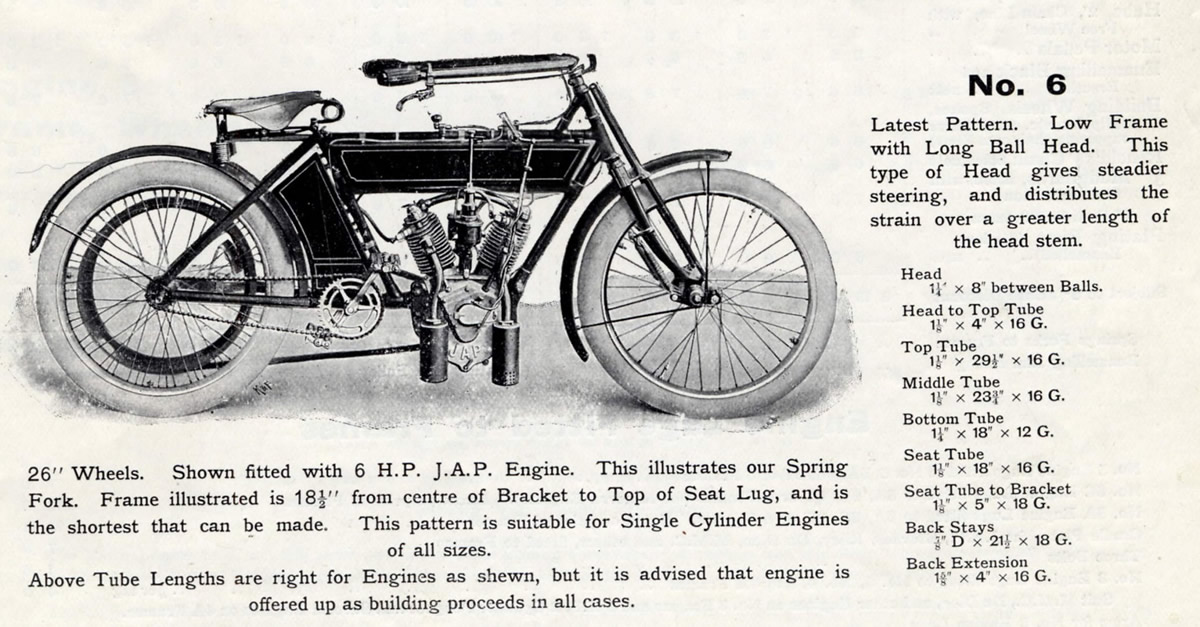
In the two pictures below you can see that the Chater Lea frame No 4 from 1904 (left) is a good match for the frame used in the March-November 1904 adverts.
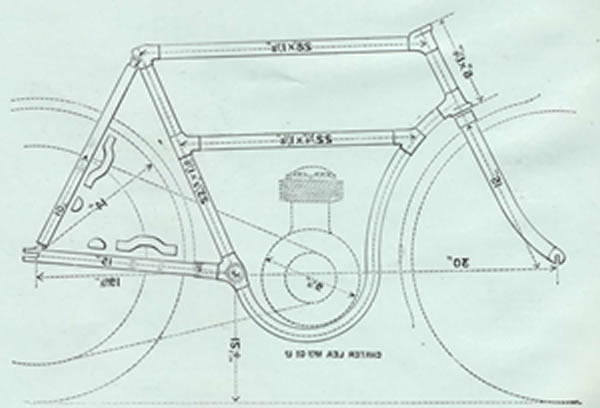
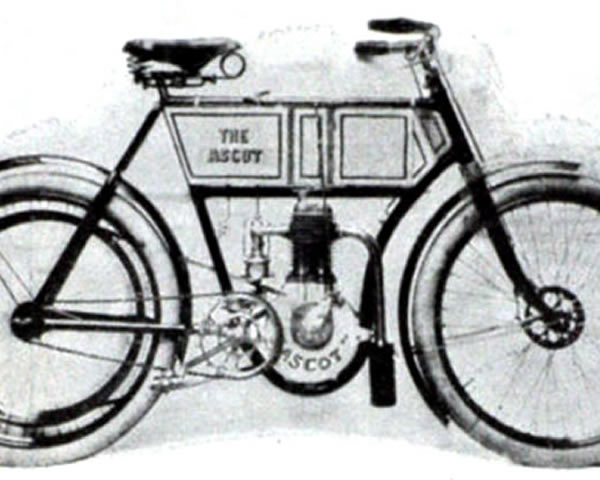
The front band brake fitted also looks like a band brake featured in the Chater Lea 1907 catalog.
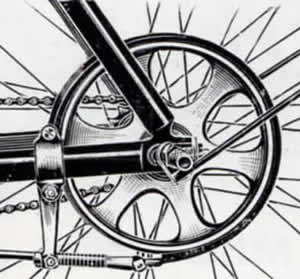
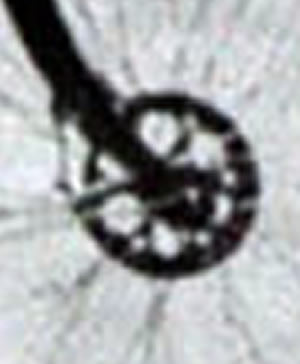
The front fork looks the same as those featured in the 1904 Cahter Lea catalog.
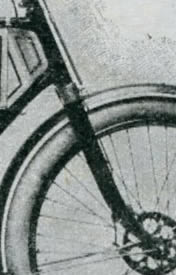
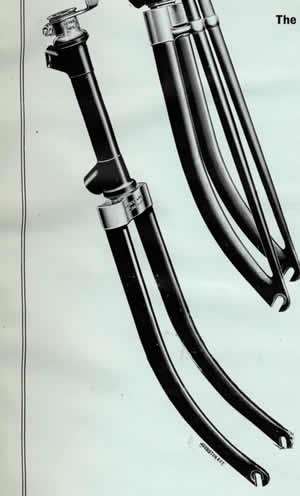
The tank featured in the 1904 Chater Lea catalog also looks to be a good match for the tank used in the 1904 high frame models, see below.
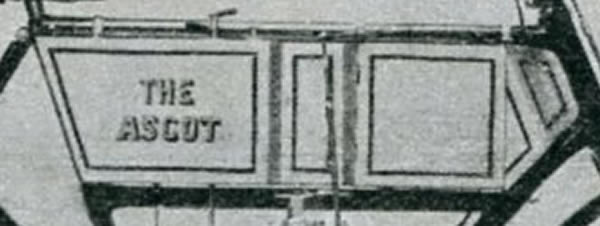
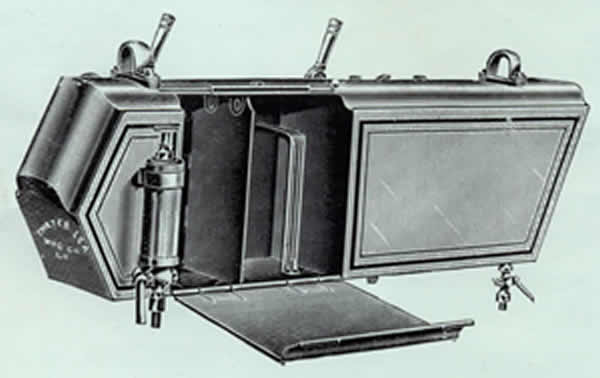
Graces Guide also lists Ascot at being at at Pixmore Avenue, Letchworth - though as yet I know no now than that. I think Graces guide is wrong here (maybe) as there was also a later Ascot Motor Co that made cars and they were in Letchworth c1928.
I have searched through the following publications and Ascot information is rather scarce.
| Title | Year | Date Range | Finds Y/N | Adverts | Source | Notes |
| Motor Cycling | 1902 | 12th Feb to 6th Aug | N | N | GM | Nothing |
| The Motor Cycle | 1903 | 31st Mar to 30 Dec | N | N | GM | Nothing |
| Autocar | 1903 | Full Year | N | N | VCC | Nothing |
| Crystal Palace Show Guide | 1903 | February | N | N | VCC | Nothing |
| Patents | 1903 | Jan03 to Dec06 | N | N | VCC | Nothing |
| The Motor | 1903 | 12th Aug to 31st Dec | N | N | GM | Nothing |
| Autocar | 1904 | Jan-June | N | N | VCC | Nothing |
| Crystal Palace Show Guide | 1904 | February | N | N | VCC | Nothing |
| Horseless Age | 1904 | Full Year | N | N | VCC | Nothing |
| Show Agricultural Hall, London | 1904 | March | Y | Y | VCC | Advert & Summary |
| The Motor | 1904 | Full Year | Y | Y | VCC | Adverts March - June 1904 only |
| The Motor Cycle | 1904 | Jan to Dec | Y | N | GM | Brief mention in Nov show reports |
| The Motor News (Dublin) | 1904 | Full Year | N | N | VCC | Nothing |
| Olympia Show | 1905 | February | N | N | VCC | Nothing |
| The Motor Cycle | 1905 | Jan to Dec | N | N | GM | Nothing |
| Birmingham Show Guide | 1907 | January | N | N | VCC | Nothing |
| Still to Find/Research | ||||||
| Stanley Show Guide | 1904 | November | Ascots did exhibit so should be info | |||
| The Queen 1904 reviewed bikes | ||||||
| Pall Mall Gazette reviewed bikes in 1904 | ||||||
| Bicycling News 1904 maybe Dec metions Ascots tiny french | ||||||
The MotorCycle of 1903 makes no mention of Ascot at the Stanley Show.
The Motor from August 12th 1903 to December 31st 1903 has no mention of Ascot.



The advert above was the first clue as to what colour my Ascot was painted. I thought that finding out what a 1903 version of Elswick Green looked like would be an impossible task, but research continues and I found a 1903 catalogue from another of the era wholesalers of part for motorcycles - Brown Brothers.
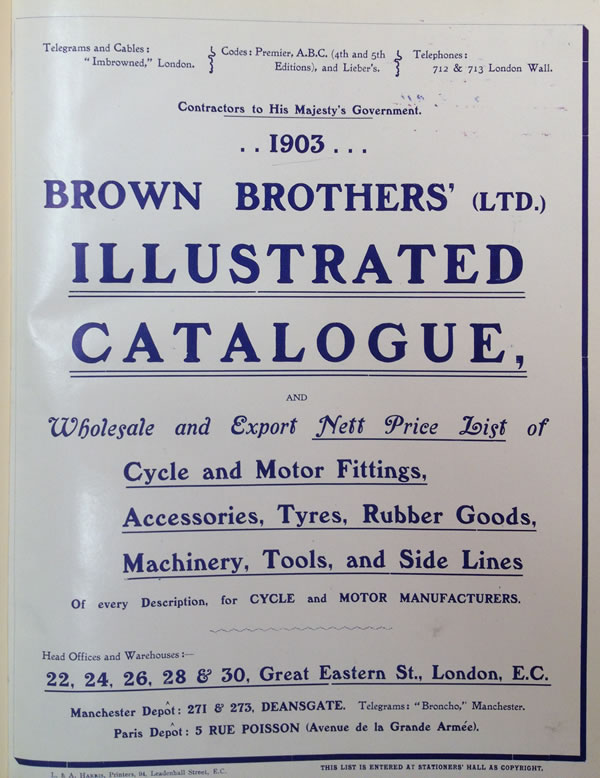
To my great surprise buried inside it they had adverts for paint and paint example/swatches and inside them was one for Elswick Green!
I doubt if this book has been open to light many times in the last 110 years and all of the colours still seem bright and unfaded, so now I just need to match the paint and I know the correct shade of dark green to paint the frame.
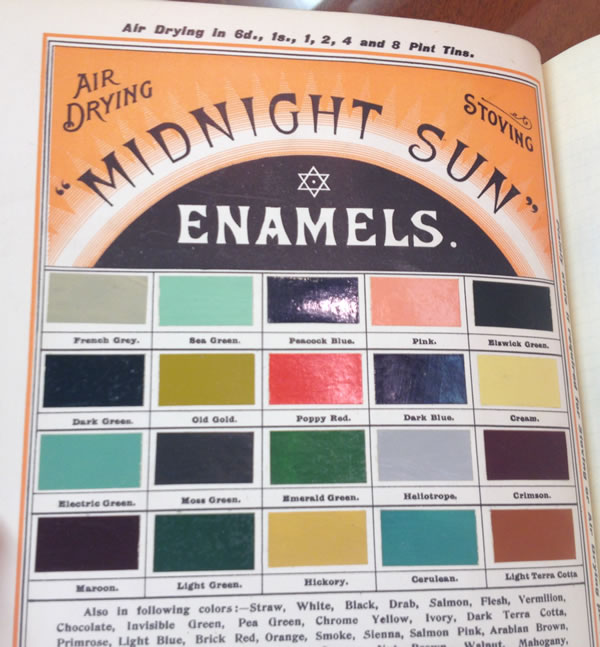

The above refers to a Bowden rear brake and so below is a period Bowden rear brake advert.

In The Motor of March 22nd 1904 they had a Show guide and mentioned Ascot over the following three pages.
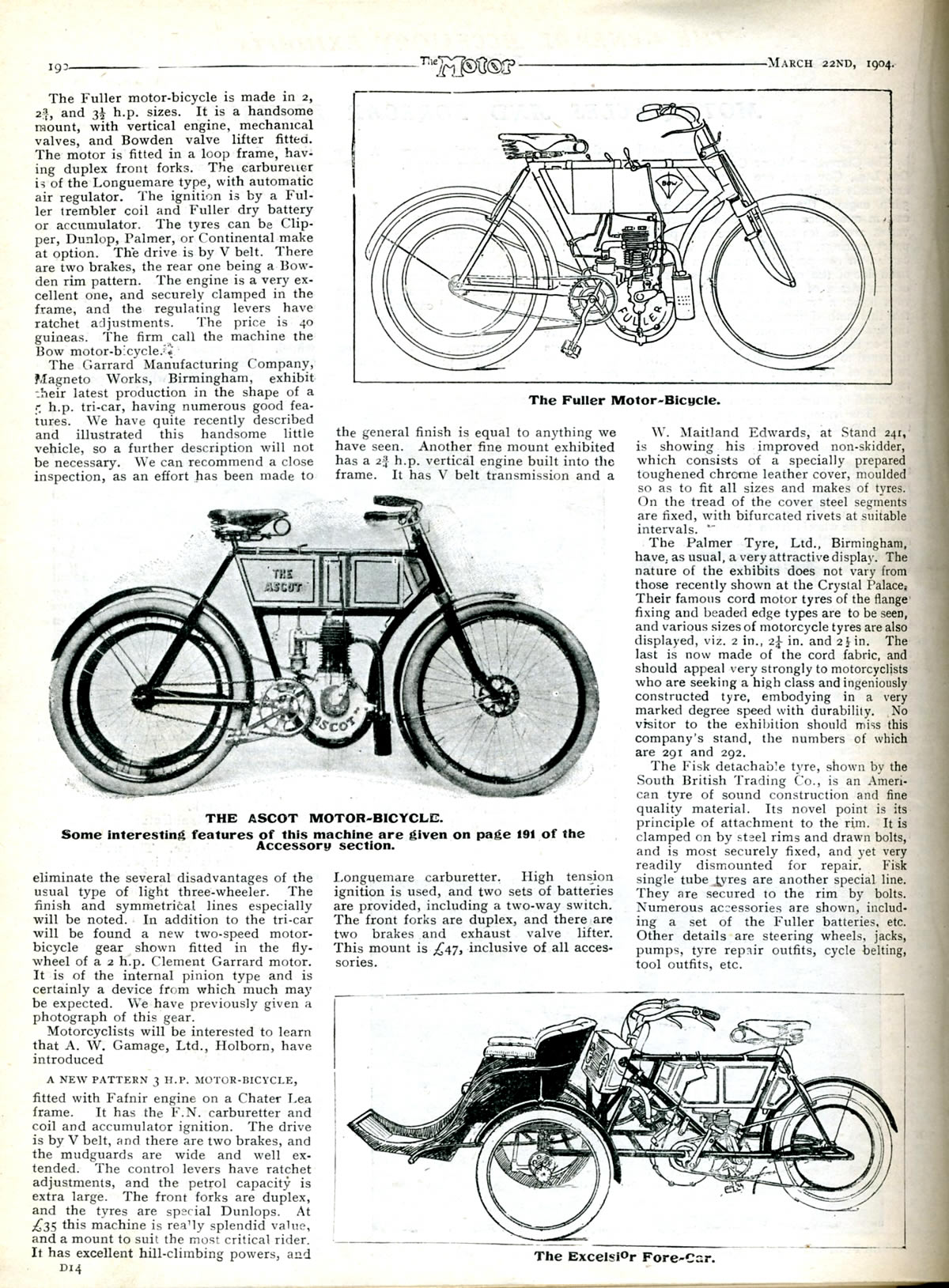
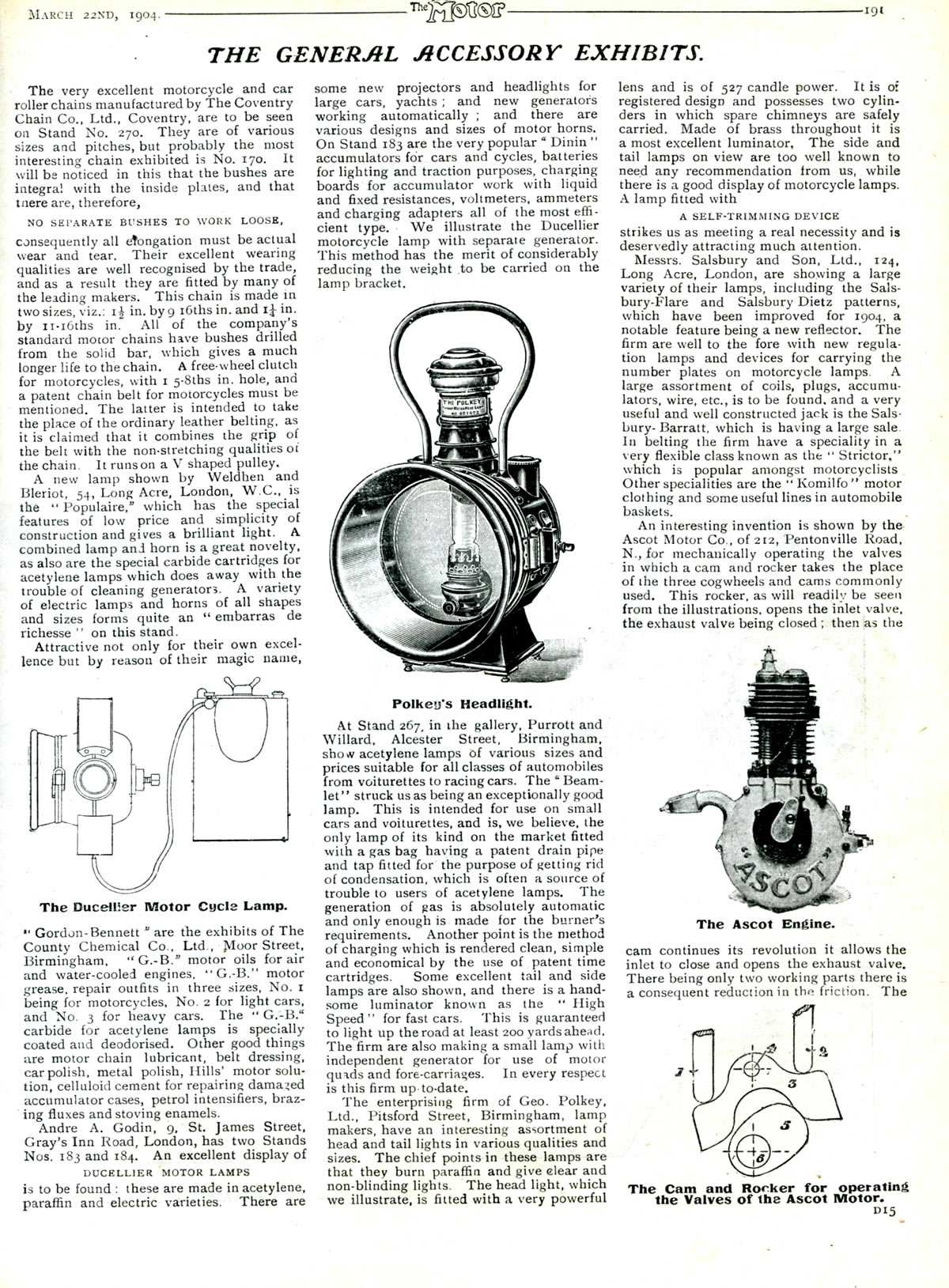
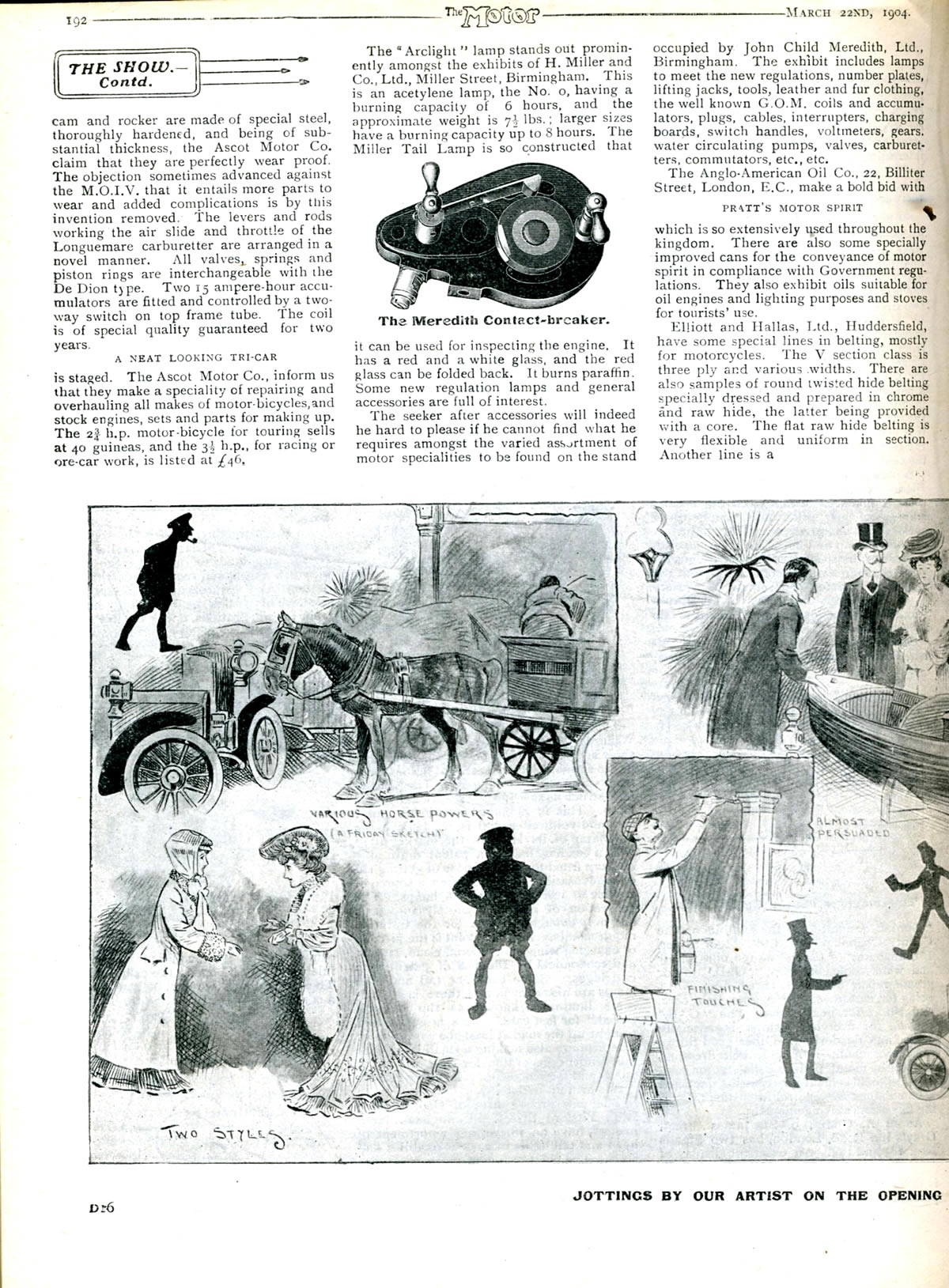
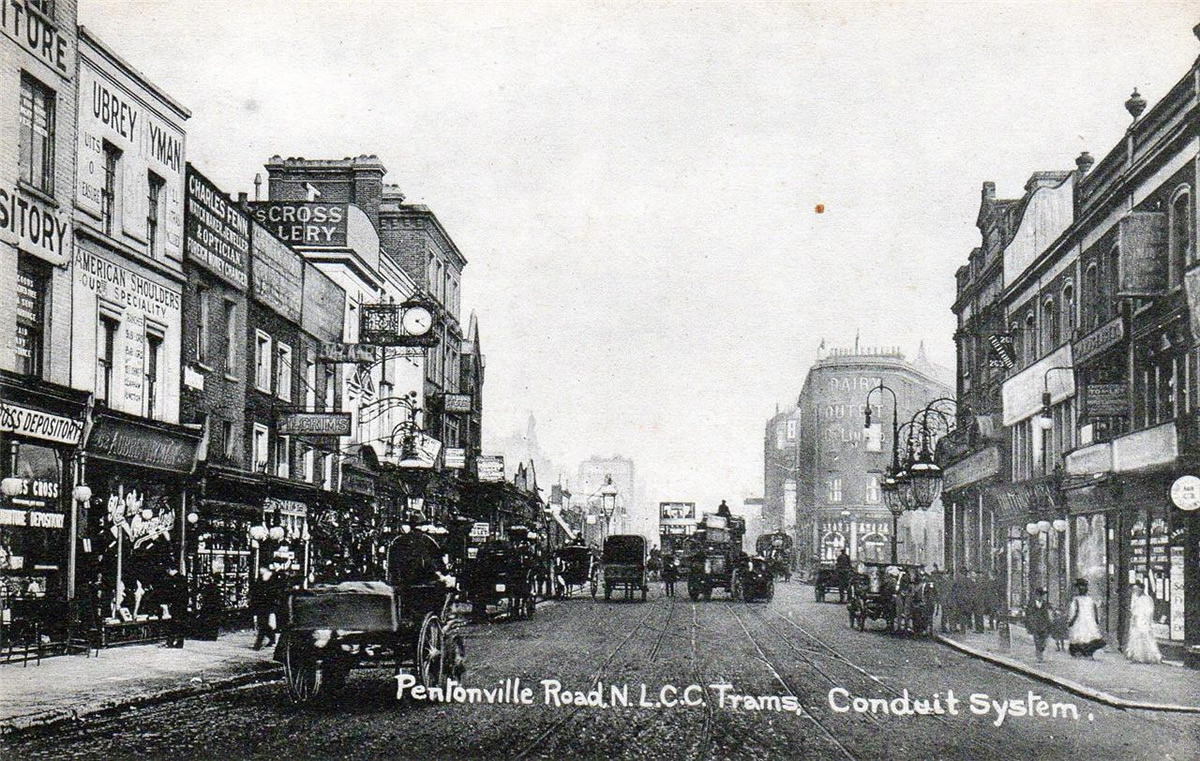
Before and after Ascot, Percy was at 187 Gray's Inn Road, which was a well to do middle class area.
The following week in The Motor, Ascot had another mention in a Show guide and the edition also featured a full page Ascot advert.
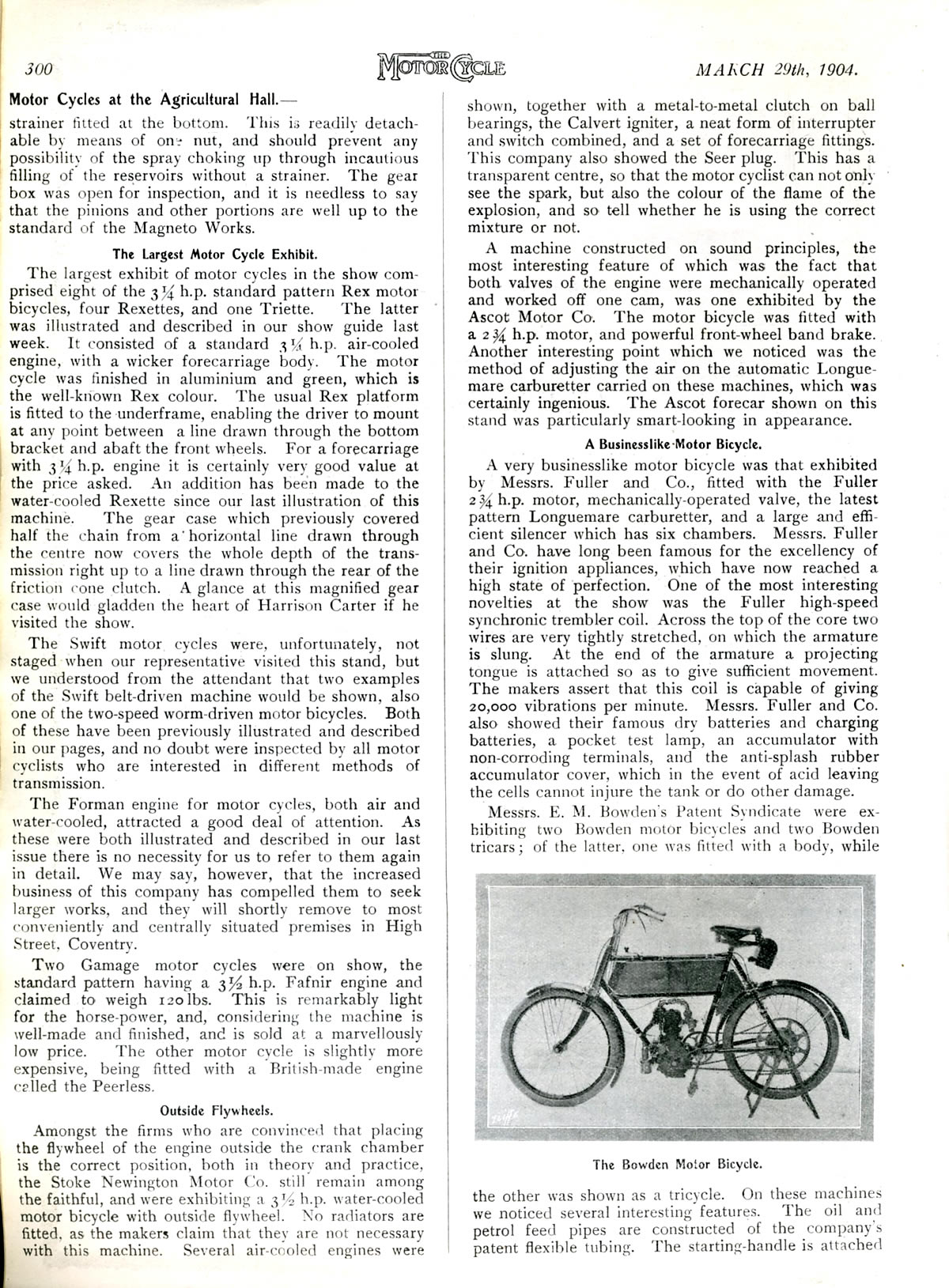
The advert below was a full page, so Ascot must have had some marketing budget to spend.
It shows a crude drawing of their method of operating both valves via a single cam. It was very advanced for its day.
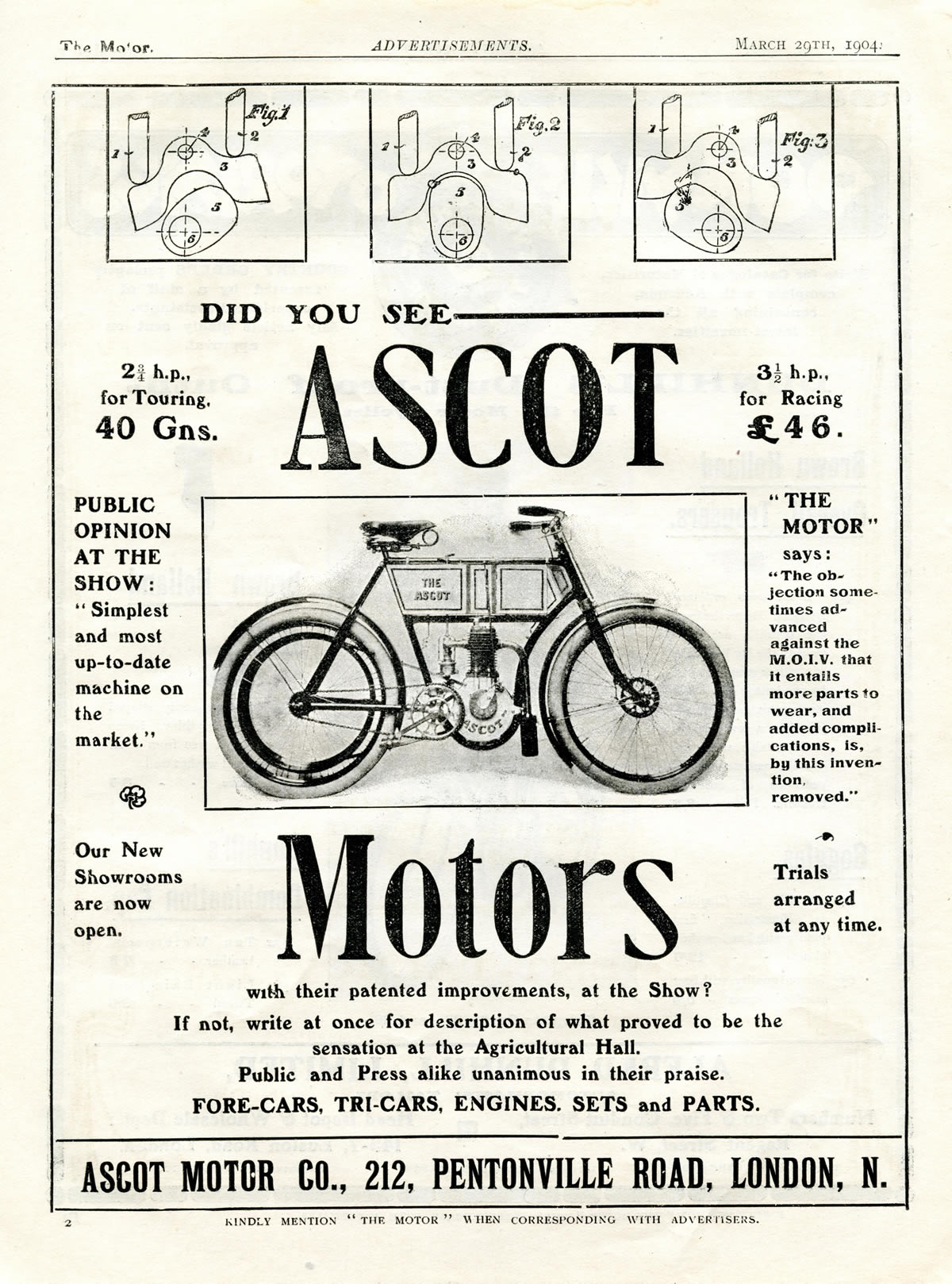
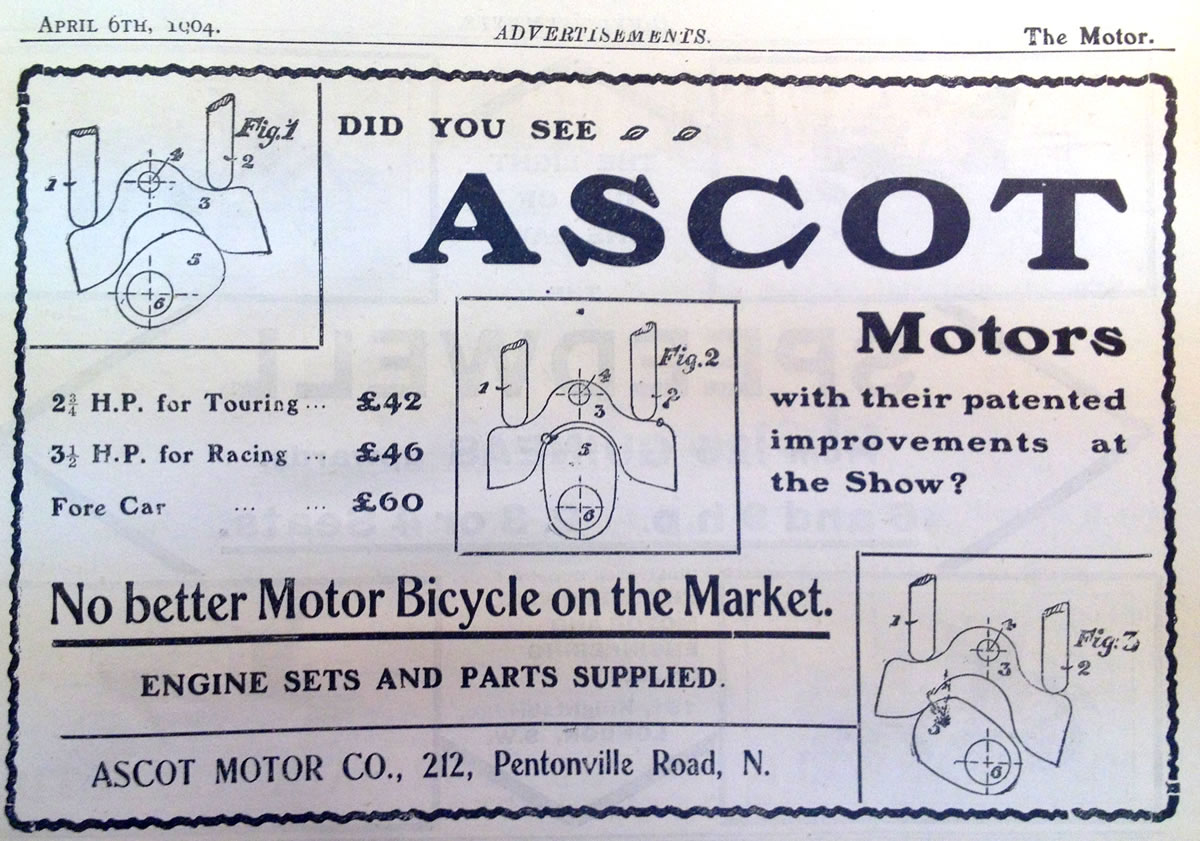
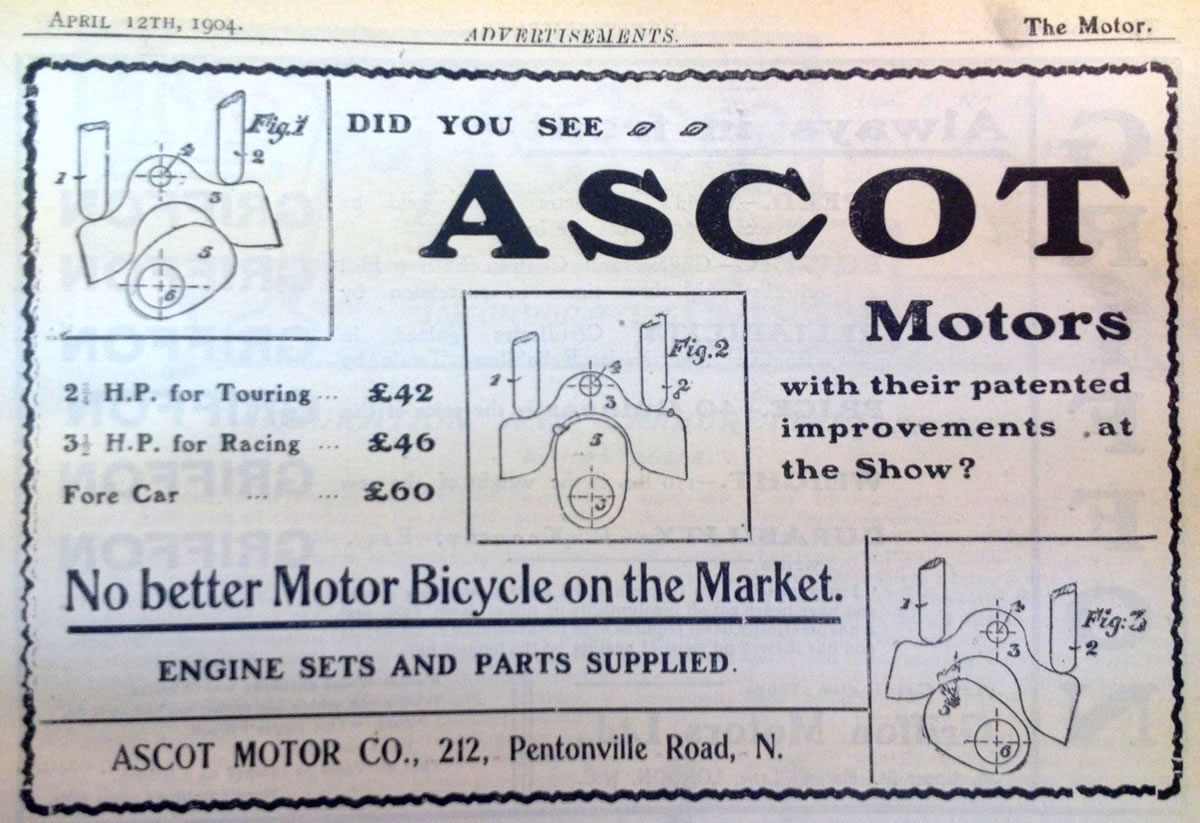

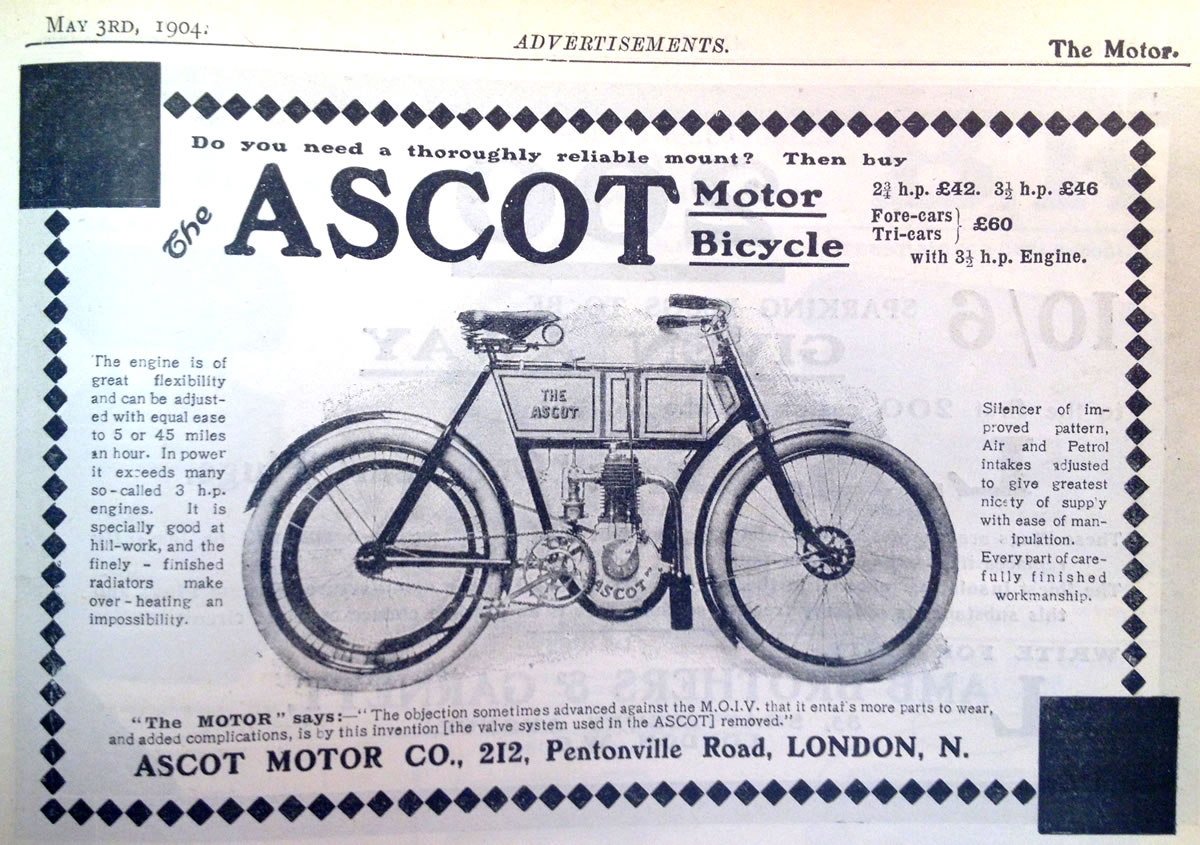
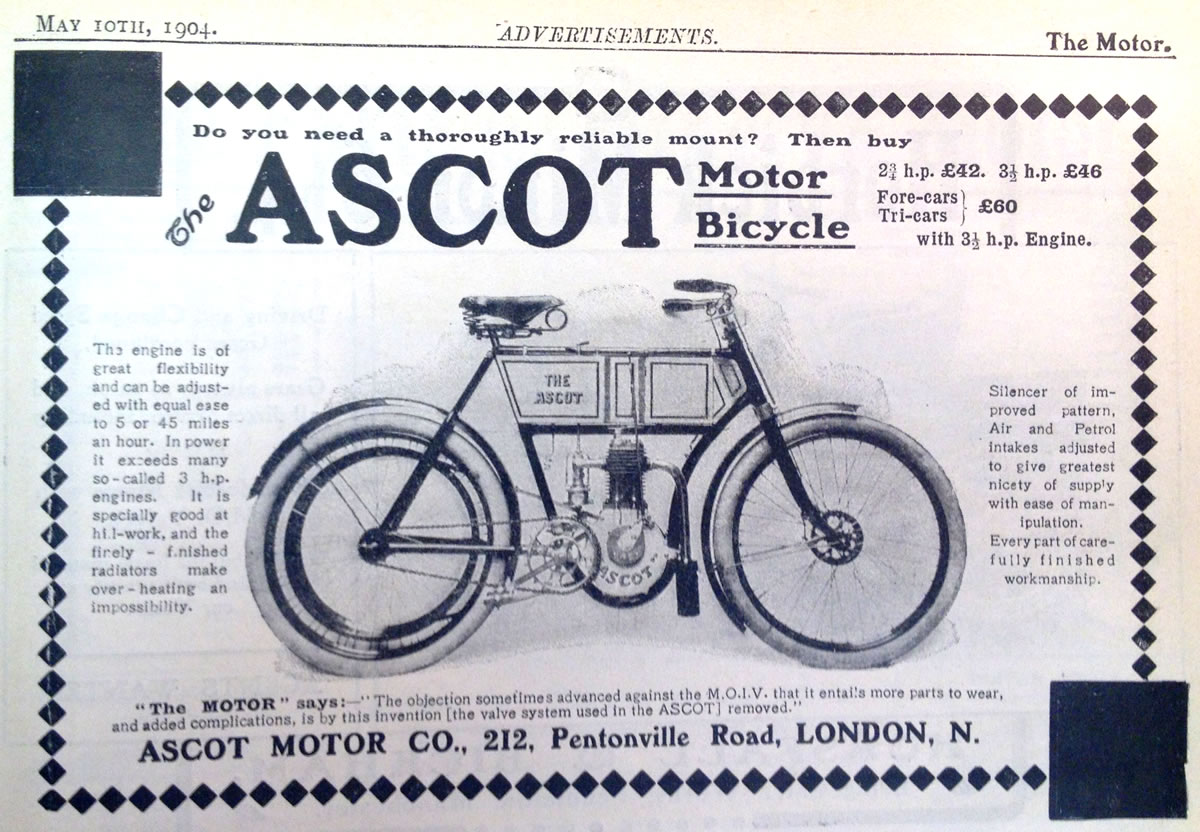
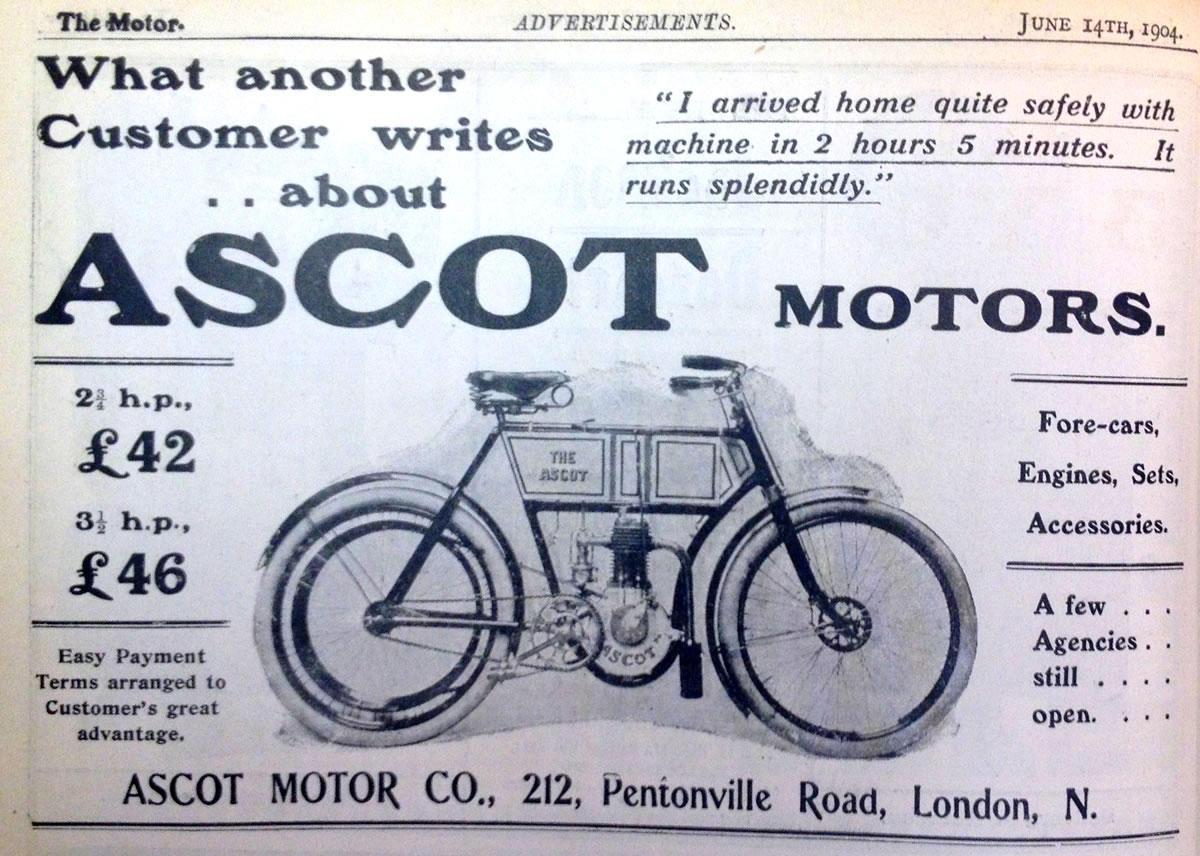
This Ascot advert below is undated and as yet from an unknown publication, but looks to be the same era as above.
The typeface/font used in the adverts varies slightly with each advert and gets closer to the font cast into the engine.
The font used on the tank is the same as the one used on my engine.
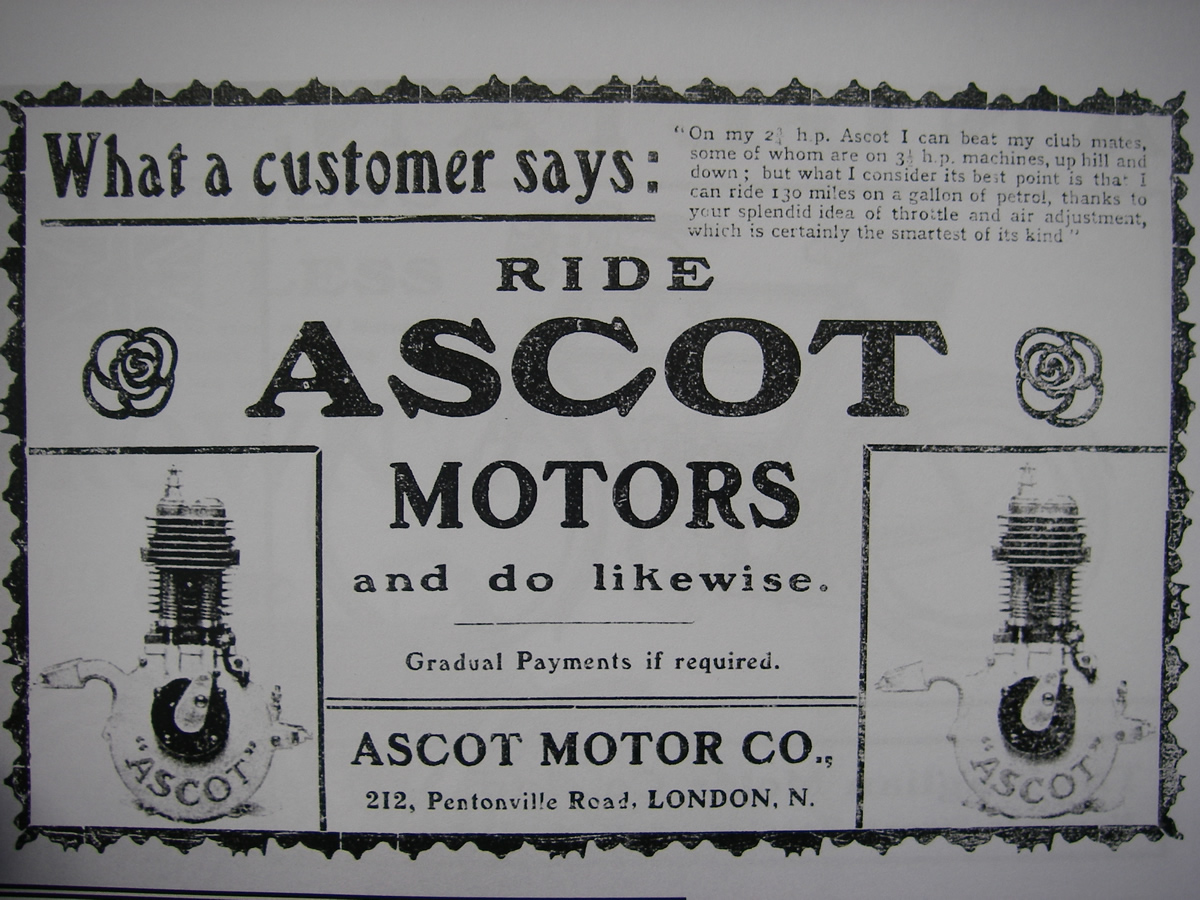
The Ascot gets a mention in an article about the forthcoming Stanley Show.

1904 November 22nd - The Motor, page 432
This edition of The Motor had another Show guide and Ascot gets a mention, though it only mentions a small bike they are importing from France.
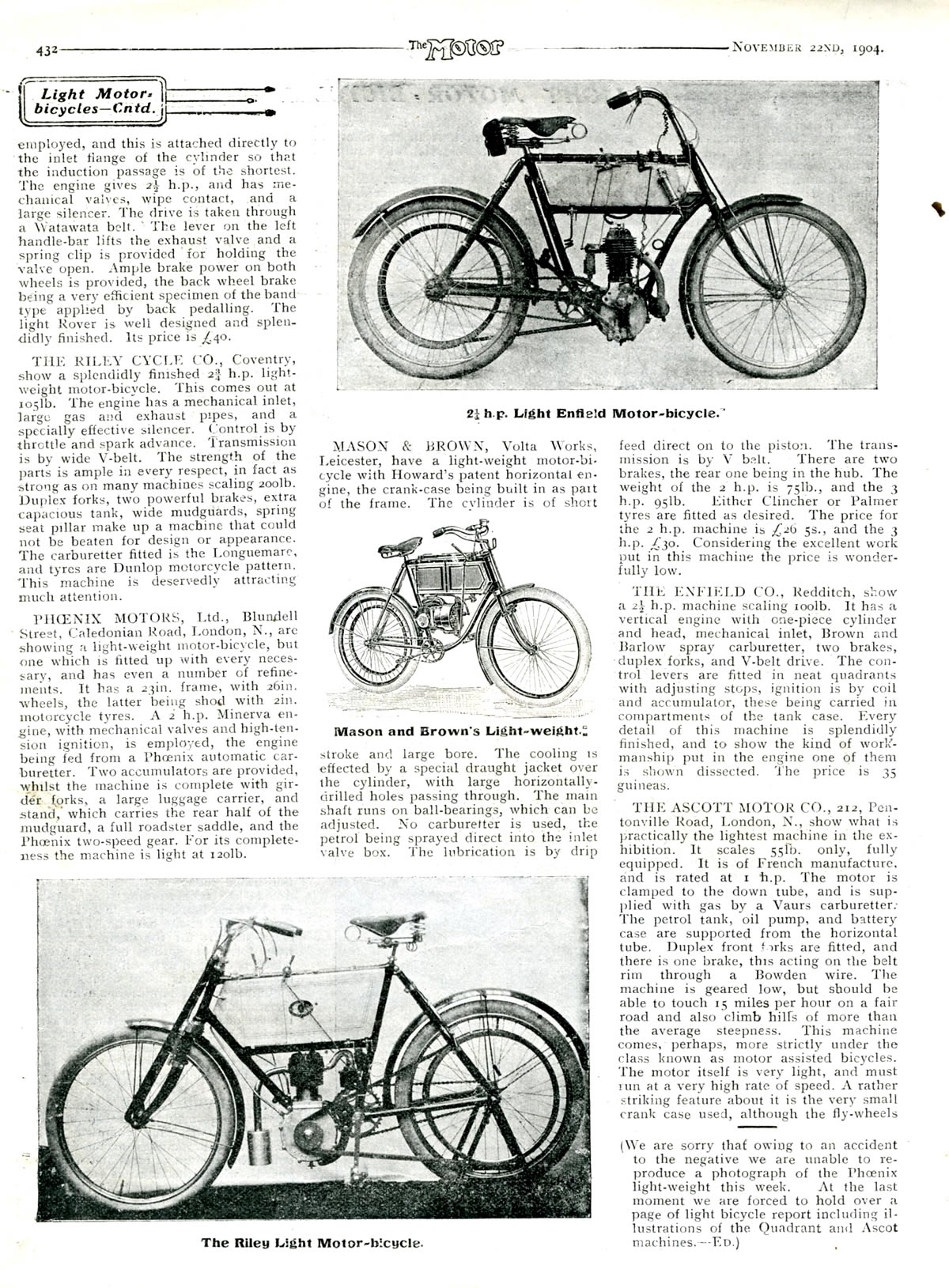
In its show guide it mentions the following and is the only mention of a foreign engine and a steel crankcase.
I am fairly sure that the "low built" frame is a Chater Lea No 6 design.

The Ascot is again mentioned in an article reviewing the show.
It refers to them displaying various bikes including one "of last year's pattern" - so they must have had a 1903 model.
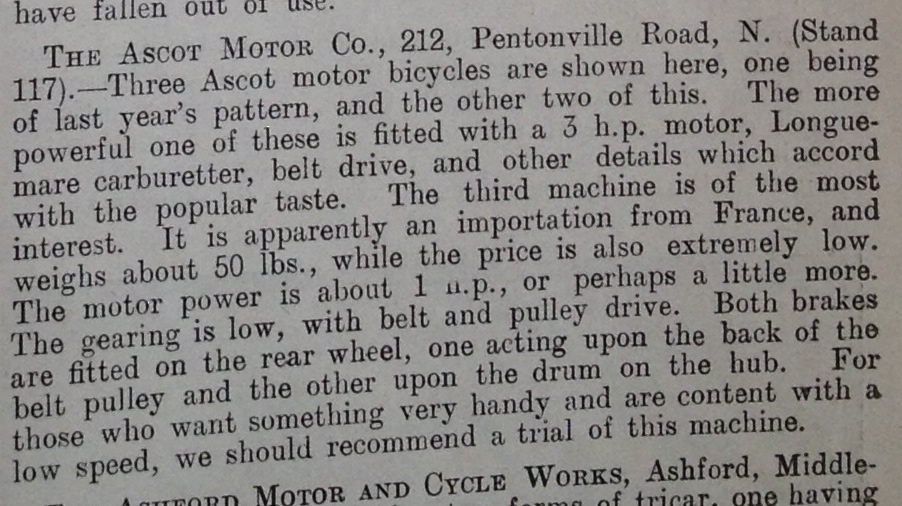
The 1hp machine mentioned above is pictured a few pages later, see below
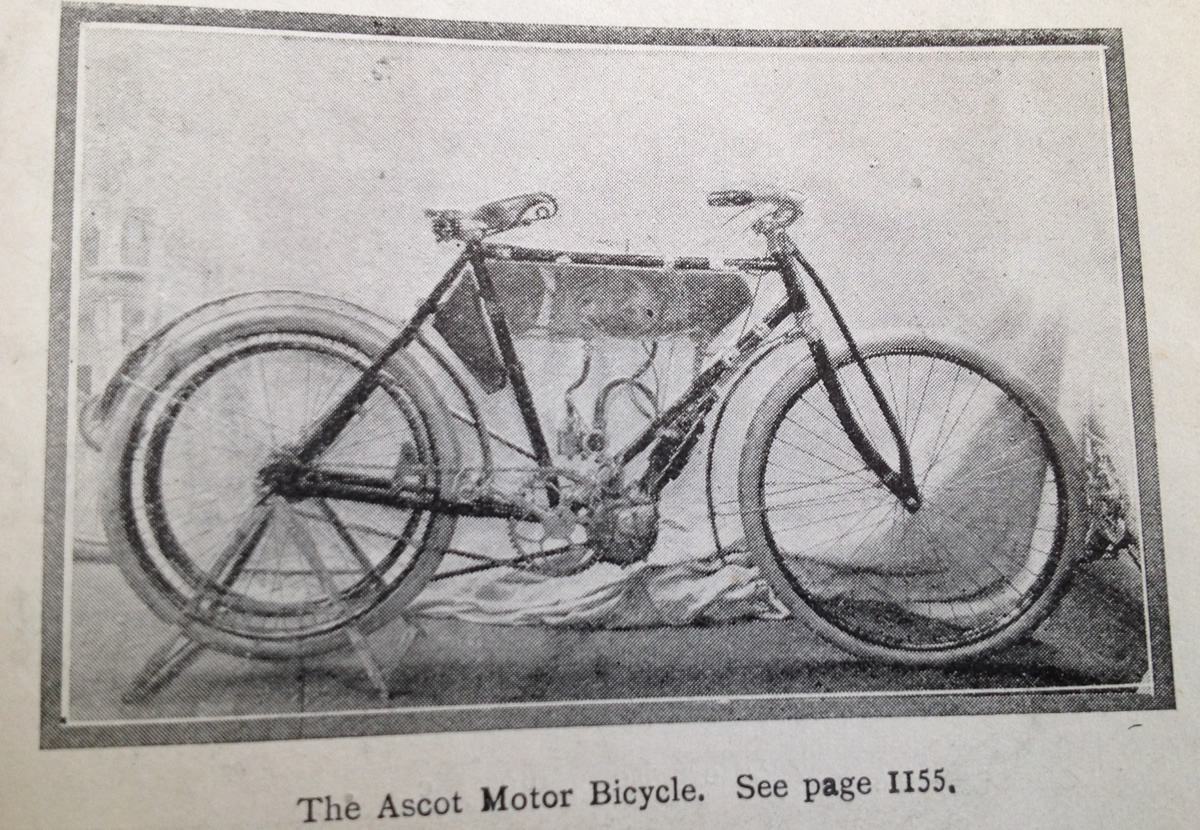
Thanks to a very knowledgeable Ken, I now know that the small machine (above) is a Herdtle & Bruneau and was considered a very fine bit of kit in its day - likened to a watch.
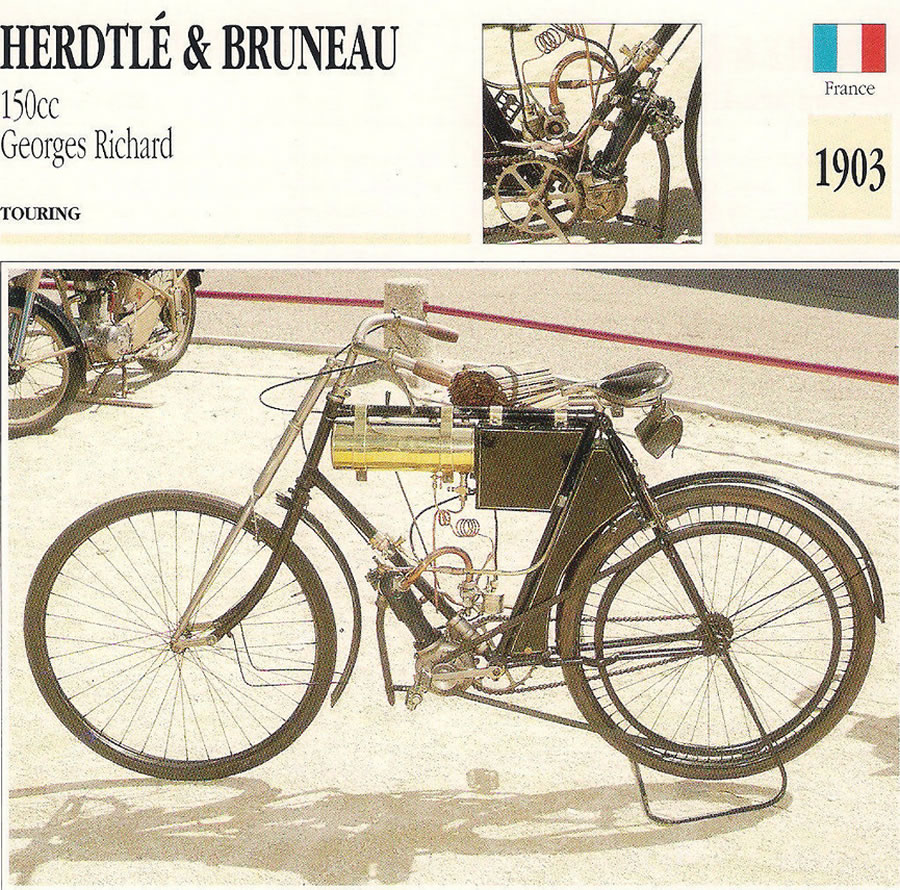
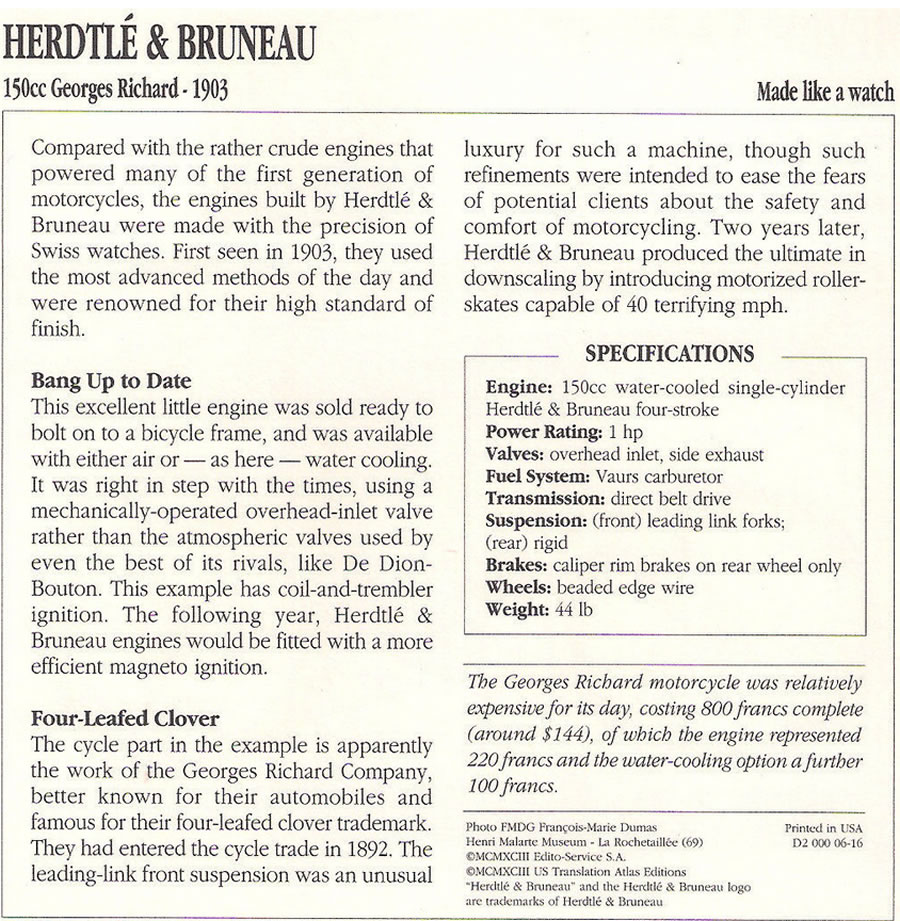
The last reference I have found for new Ascots is the 1905 editions of Peach's Motor Annual.
I assume this must have been created and printed prior to the start of 1905 - so lets assume December 1904
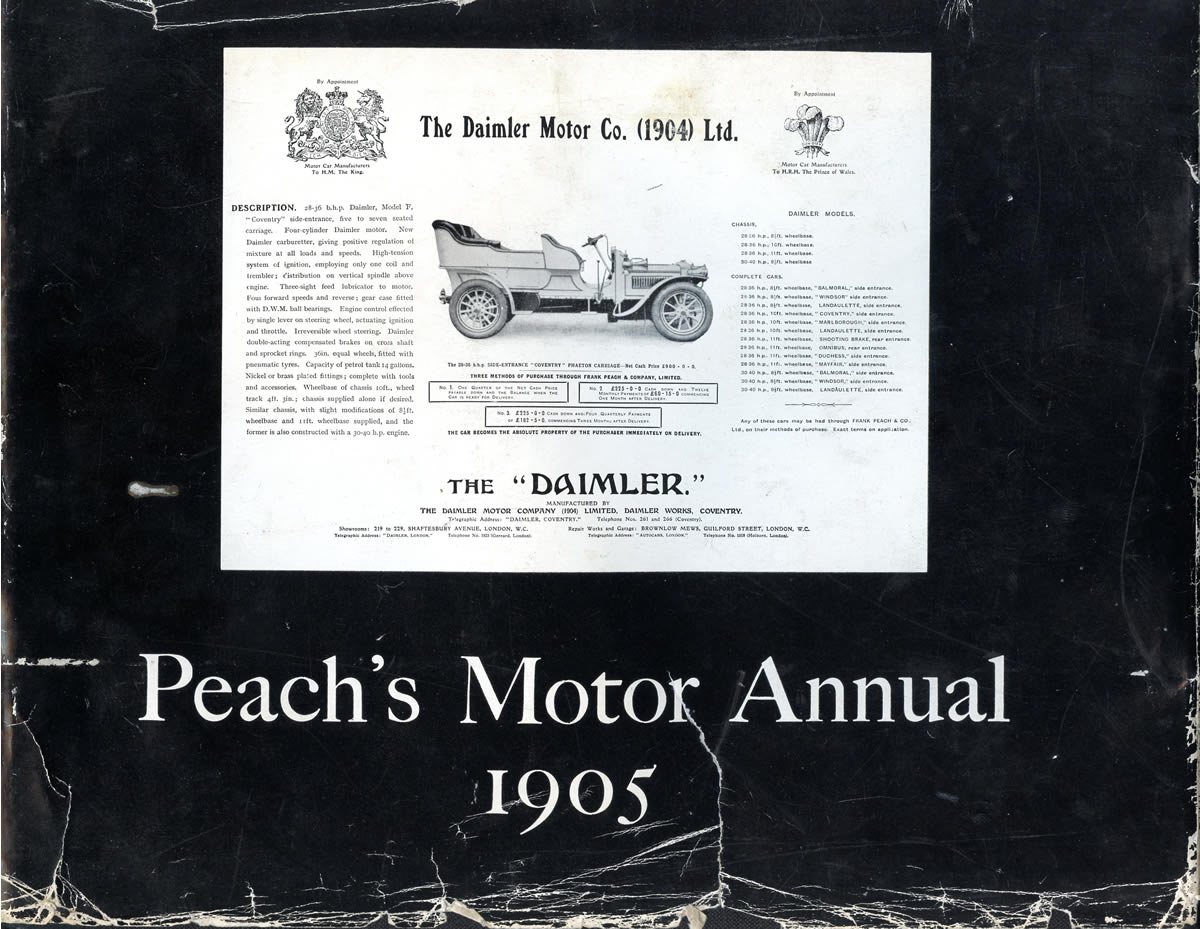
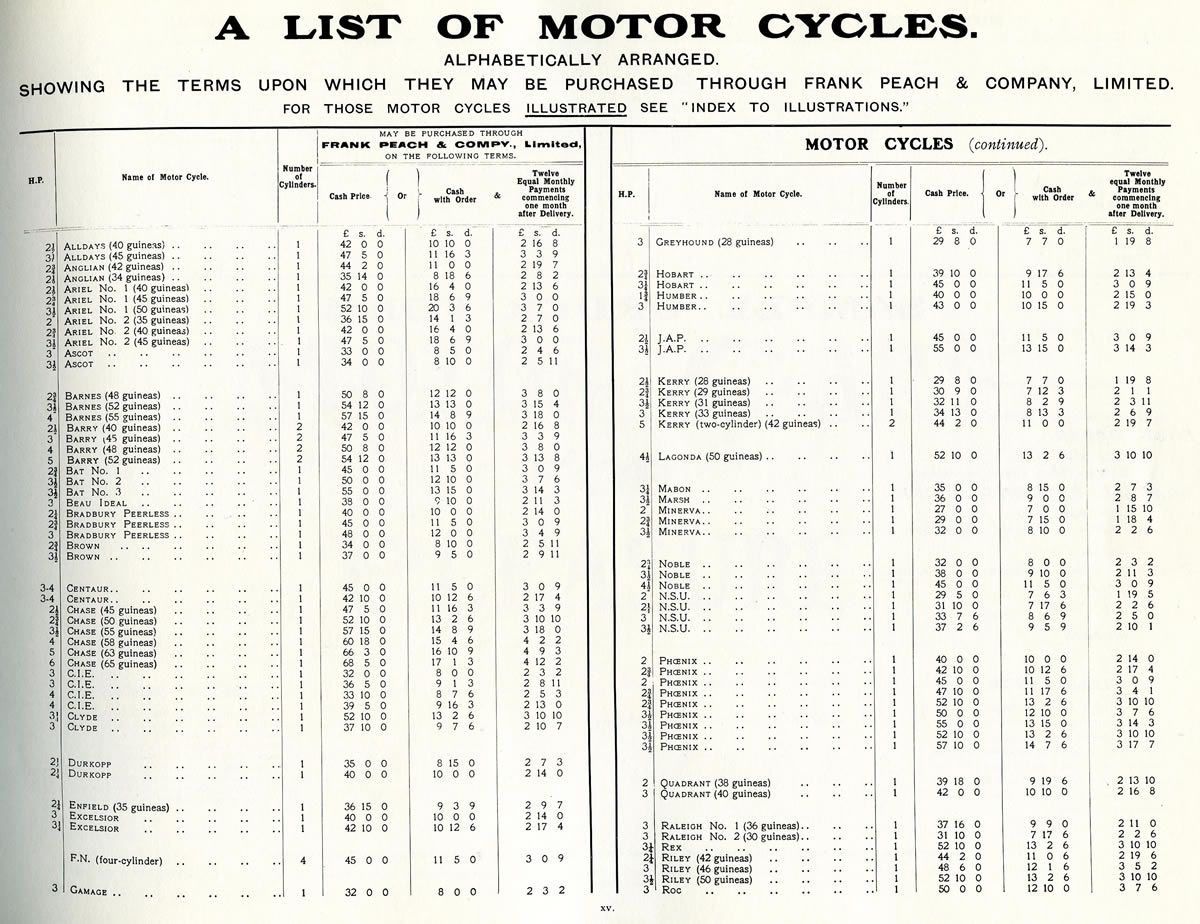
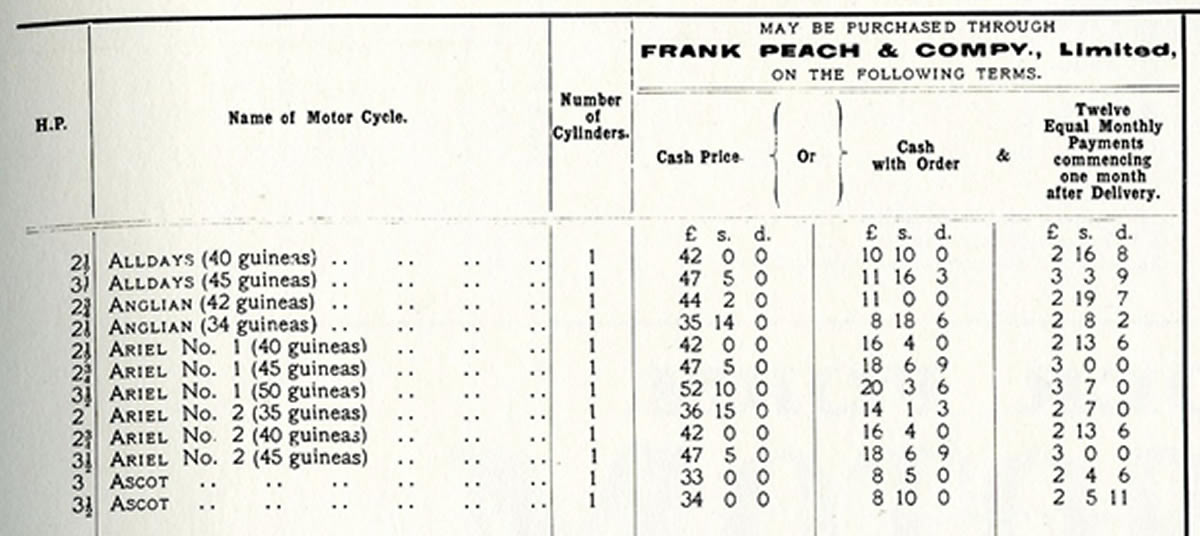
After this I can find no more references to Ascots, other than secondhand ones, so assume the company must have ceased in very late 1904 or sometime in 1905.
The secondhand adverts give useful information as it gives further clues as to numbers made and the descriptions confirm what was in the previous years adverts.
They also tell us that Ascot used Chater Lea frames for some or all of its bikes.
2 x 3.5hp Tri-cars
16 x motorcycles of which only one is rated at 2.75hp or what I believe would be a 1902/3 model
Of the 18 Ascots I have found for sale 16 of them were for sale in London and the others in Peterborough and Somerset.
As Ascot were based in London I would expect most of their sales to be local and in London.
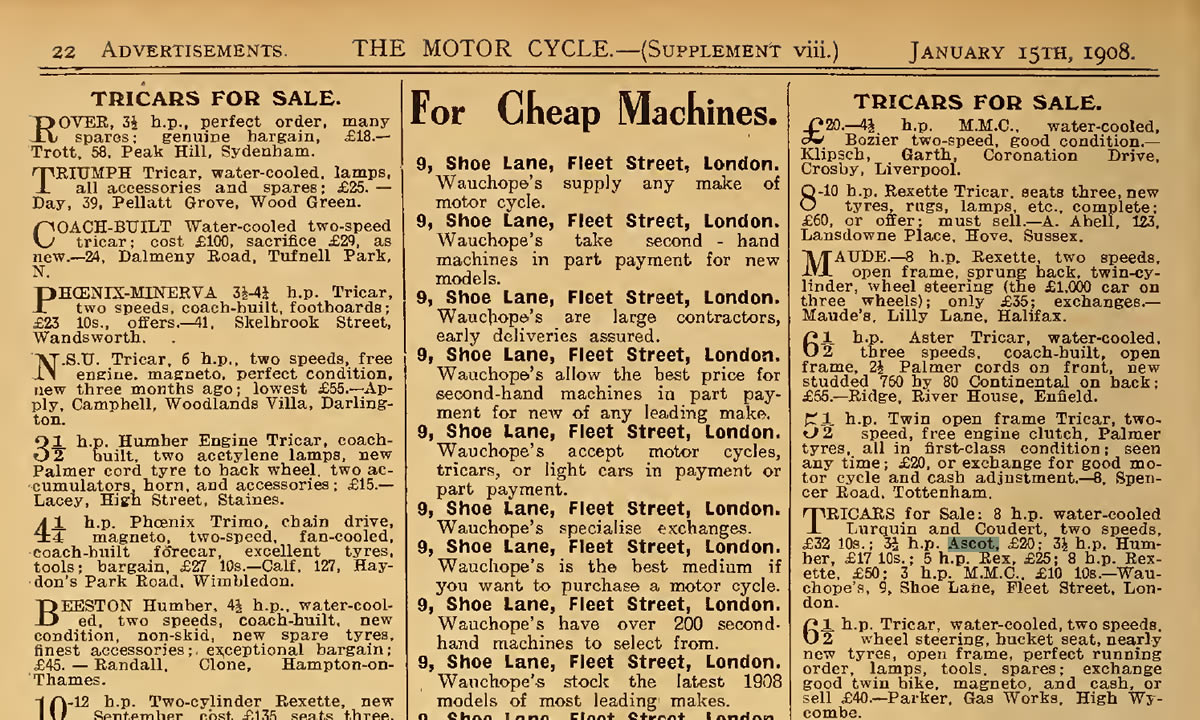
A week later a secondhand 3.5hp Ascot motorcycle is for sale in Peterborough
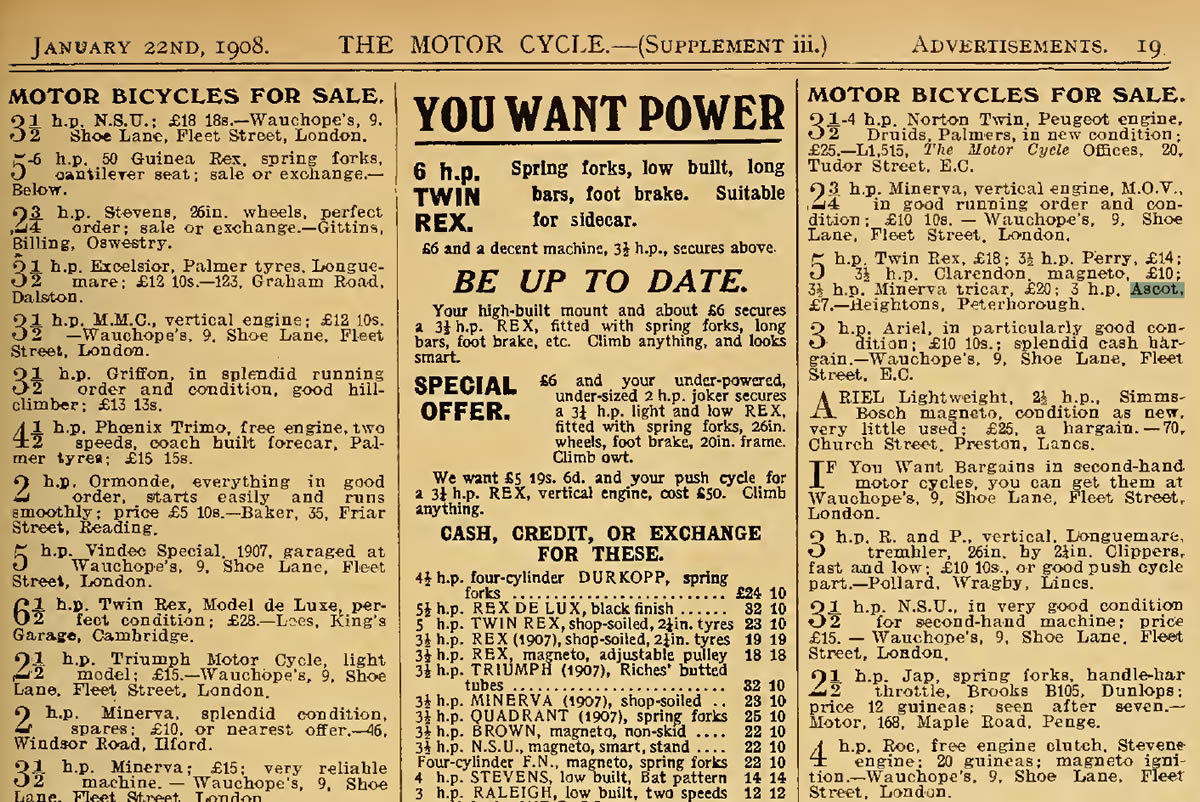
Another Ascot for Tricar for sale in January 1908 which states that you can covert it to a motorcycle, for sale in London.
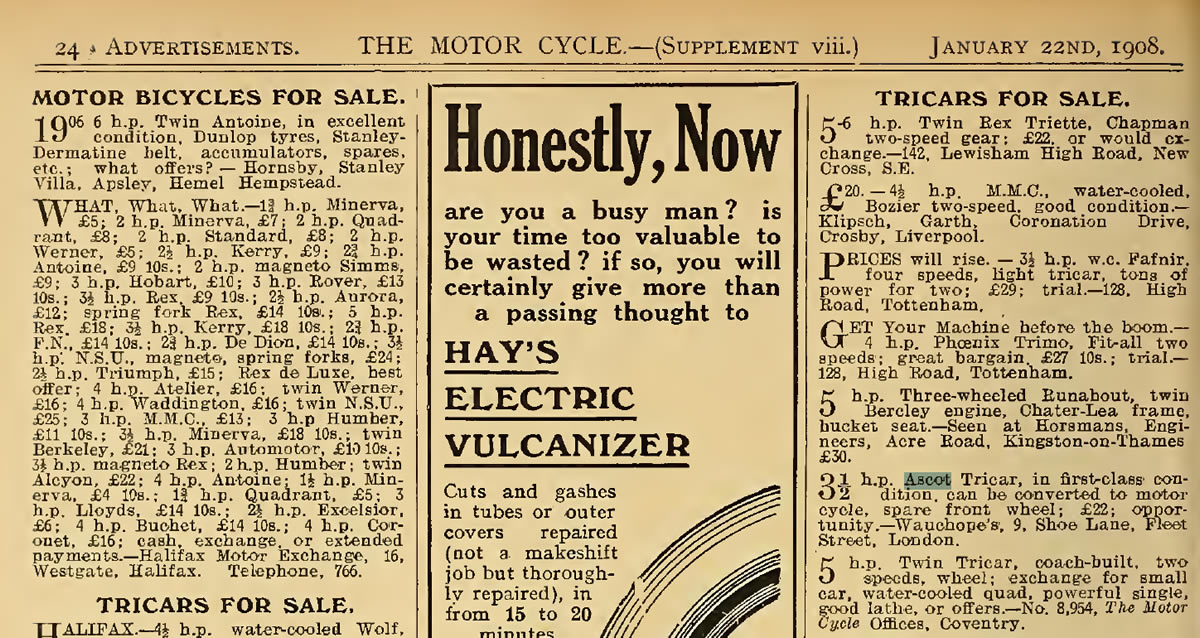
The 3.5hp Ascot motorcycle for sale below has spring forks, was this a factory development?
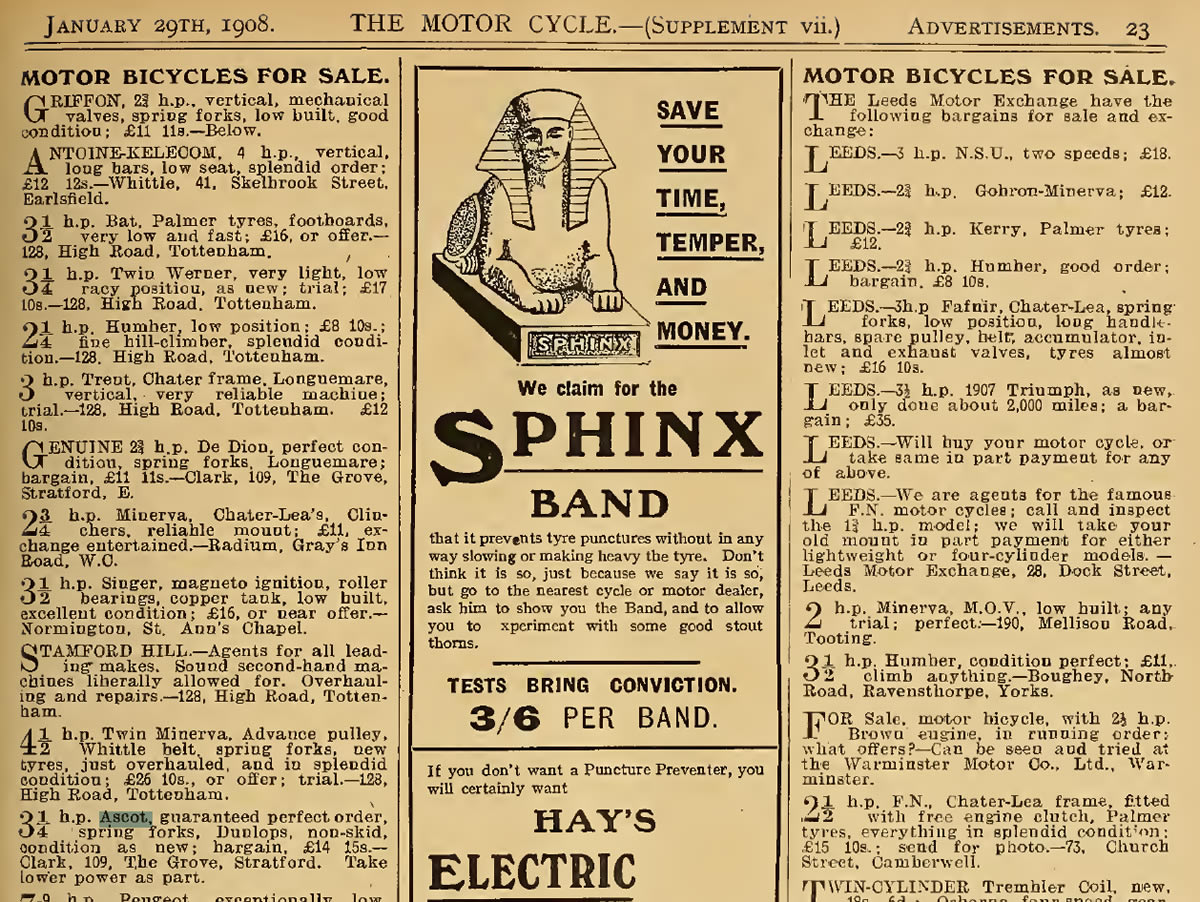
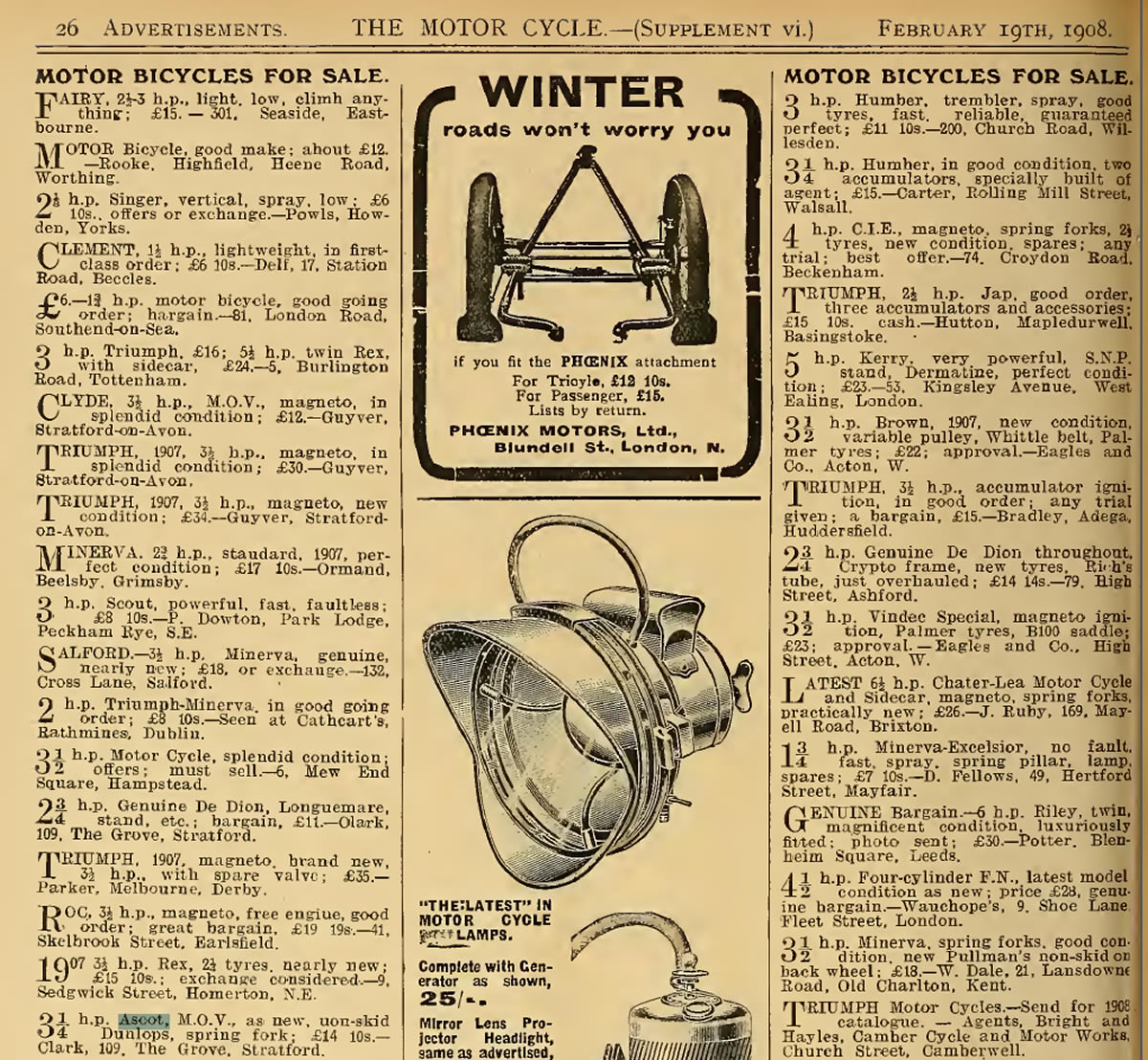
The advert for the Ascot below would suggest the seller isnt sure what size it is - maybe by 1908 they are not that well known?
The advert below has a 3.5hp Ascot Chater Lea fittings Perfect condition for £12. On the same page is a Triumph 2.5hp (so must be pre 1905) for £16.
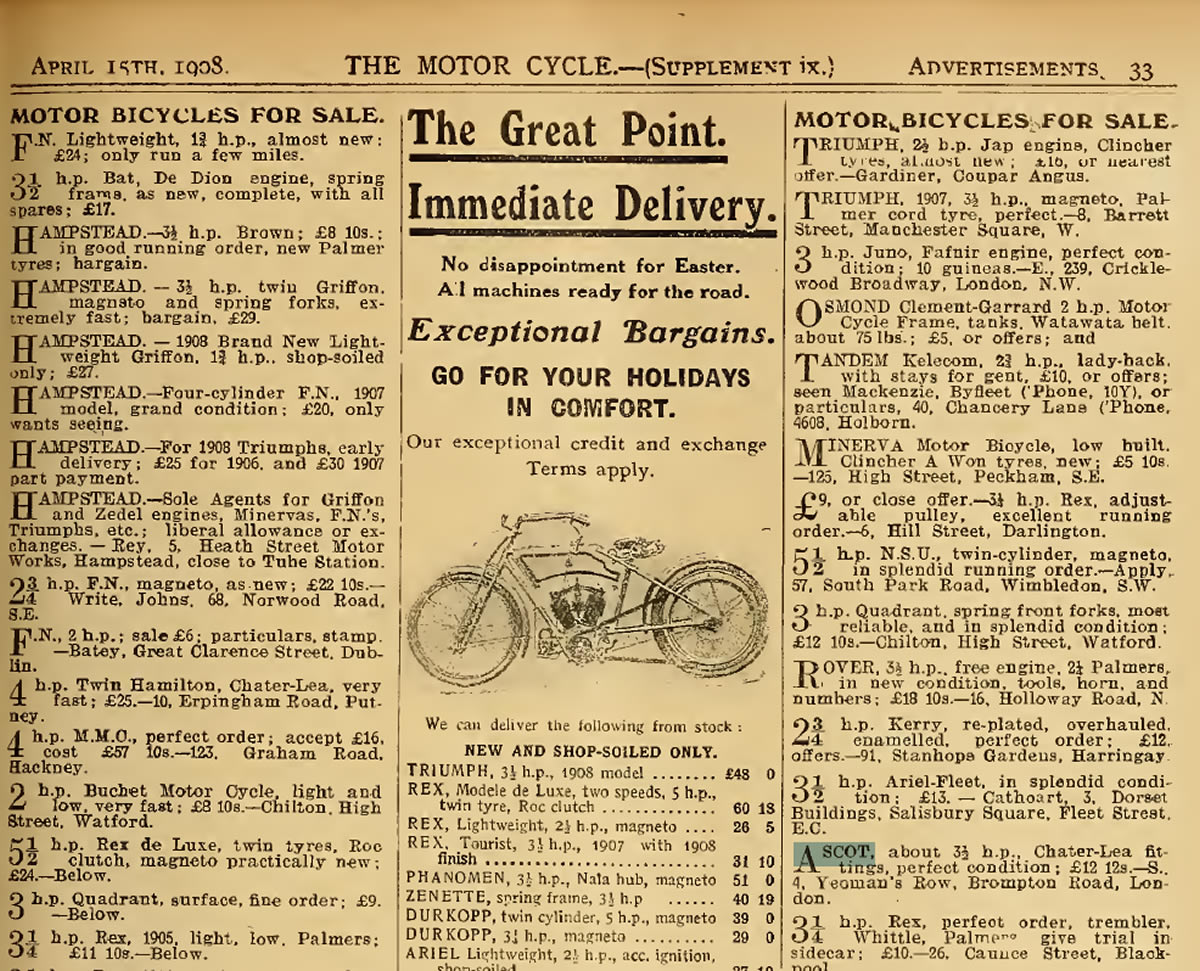
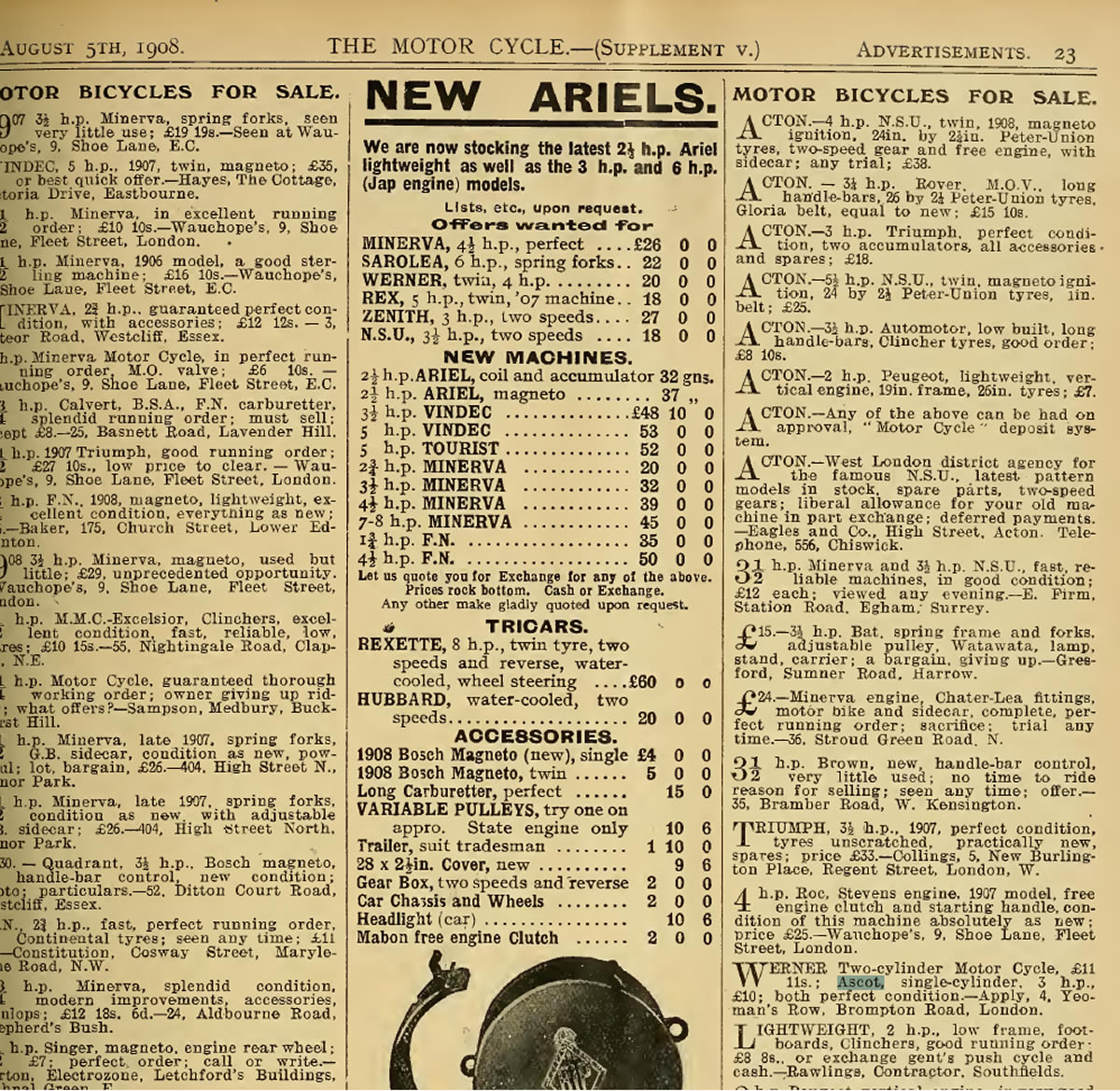
A few weeks later the above Ascot was unsold and the price was now £9 15s - it was owned by Mr Brown of 4 Yeomans Row.
The Ascot for sale below is just £10, whilst a 1907 Triumph is £27. So I suspect the Ascot is much older and hence so much cheaper.
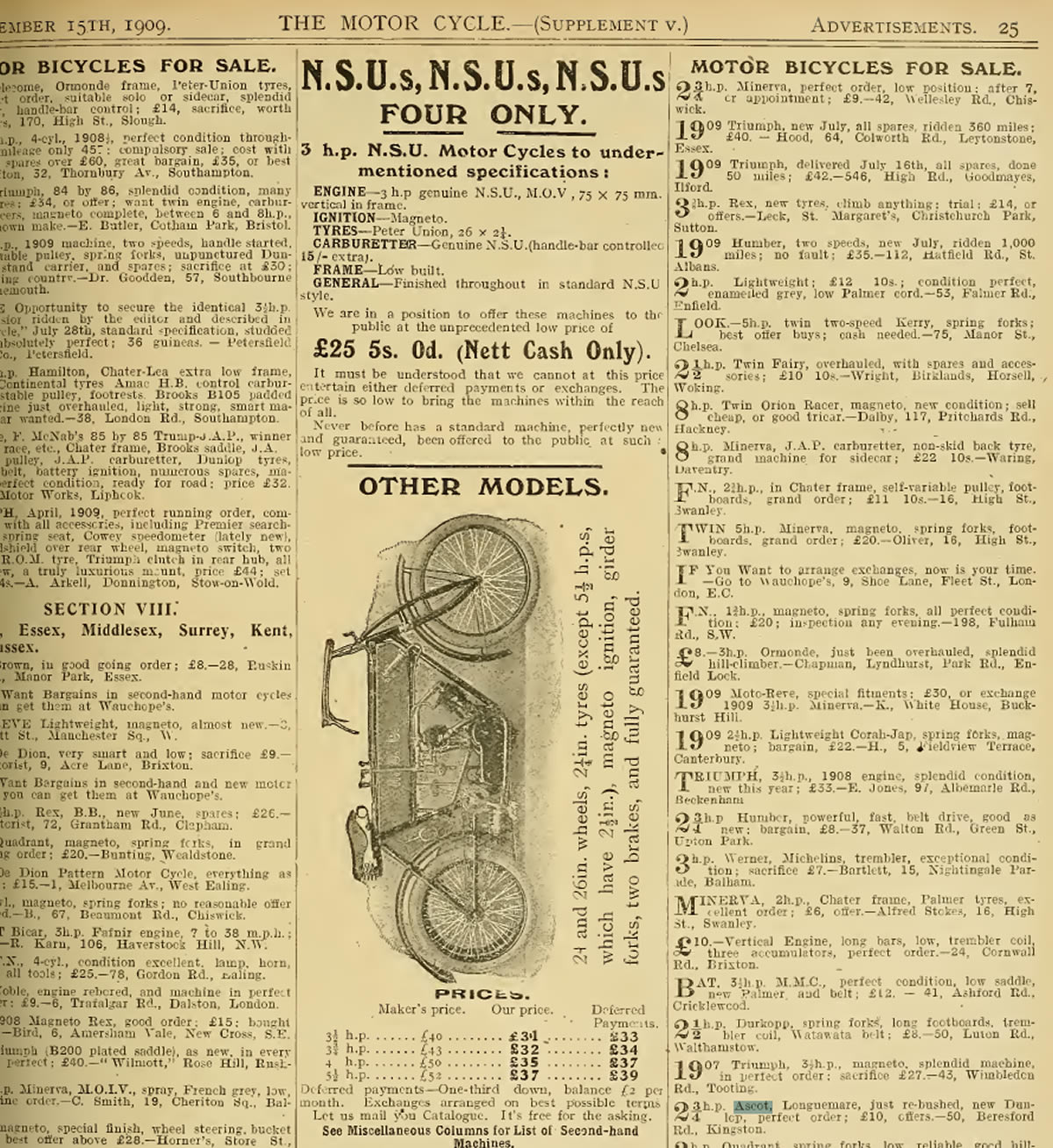
The Ascot for sale below is described as "very fast" !
The advert below says "Almost new", but is the seller meaning he recently bought it new or it is in almost new condition.
As he says he's done less than 500 miles I read it as the later.
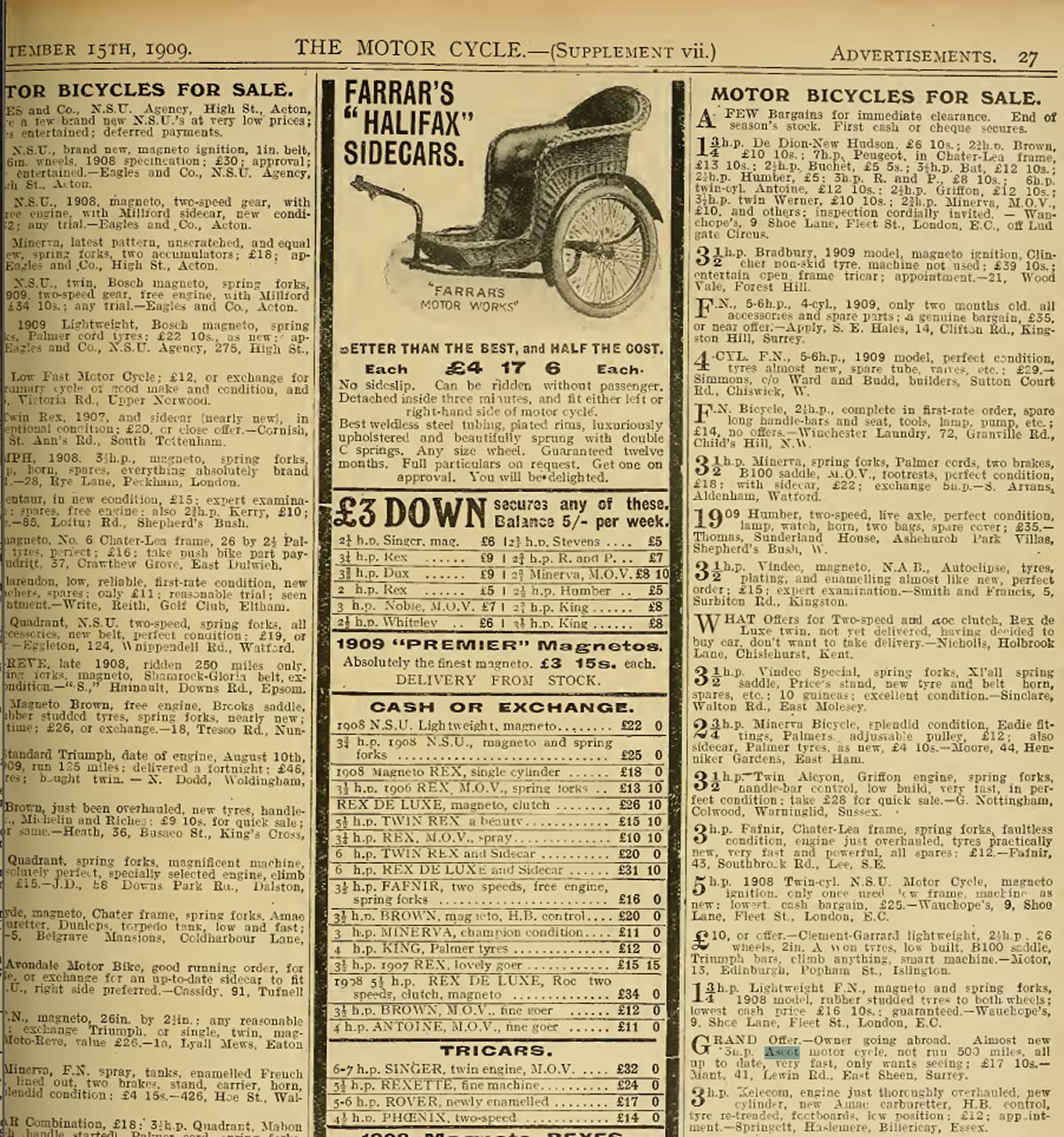
The advert below lists the bike as an Ascot Kerry of 2 5/8ths hp - maybe the engine was made by Kerry?
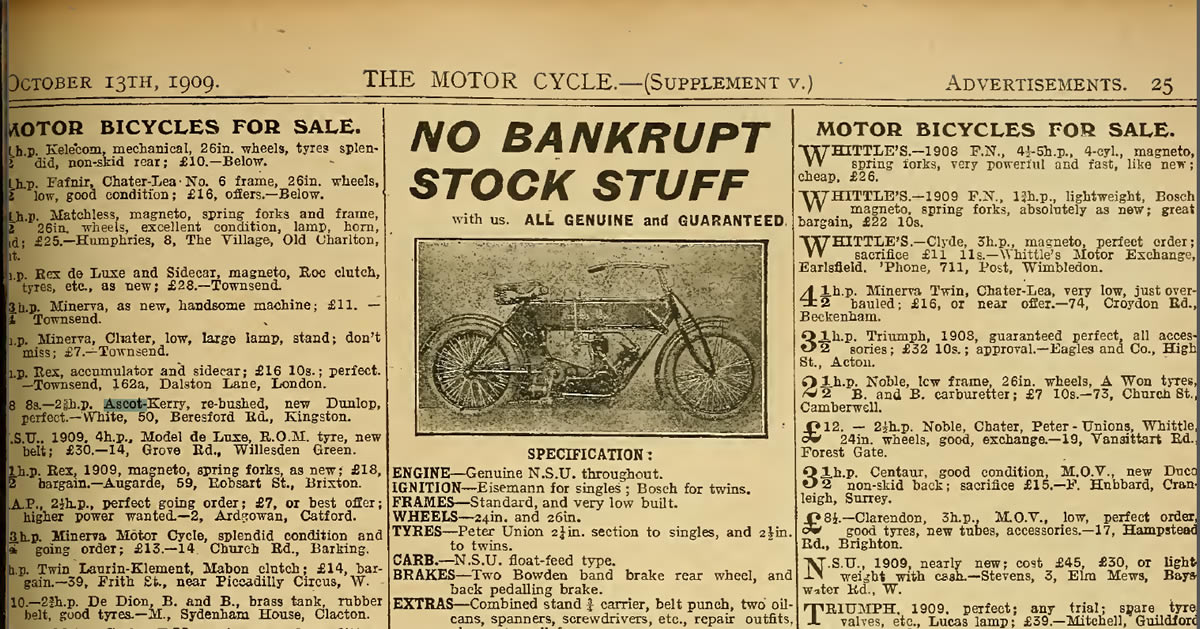
In The MotorCycle of May 19th 1910 the advert below appeared -
3h.p. Ascot, trembler coil, accumulator, lamps, horn, voltmeter, non-skid tyres, hack and front all in good condition ; £11 11s., genuine bargain.—Wright, Greyhound, Waltham Abbey.
In The MotorCycle ofFebruary 28th 1910
ELEPHANT Motor Mart,-2-3h.p. Kelecom', E.T. magneto, £12; 3.5h.p. Ascot, £6 lOs. ; 25h.p. vVerner, £5 10s.; 2h.p. Minerva, £4...
BARGAIN.—3h.p. motor cycle Ascot vertical), splendid macbine. good Dunlop tyres, just orerhanled. thorough conditjon ; £9; owner no further use; low build- Apply. F. Wheeler 6, Valis Way Frome. Somerset.
I think the above person F Wheeler was a noted local photographer.
In The MotorCycle of December 8th 1910
BARGAIN, 3 1/2h.p. Ascot, M.O.V., Amac, No- 6 frame, complete h.b.c. ; £11.-43, Whittingstall Rd., Fulham
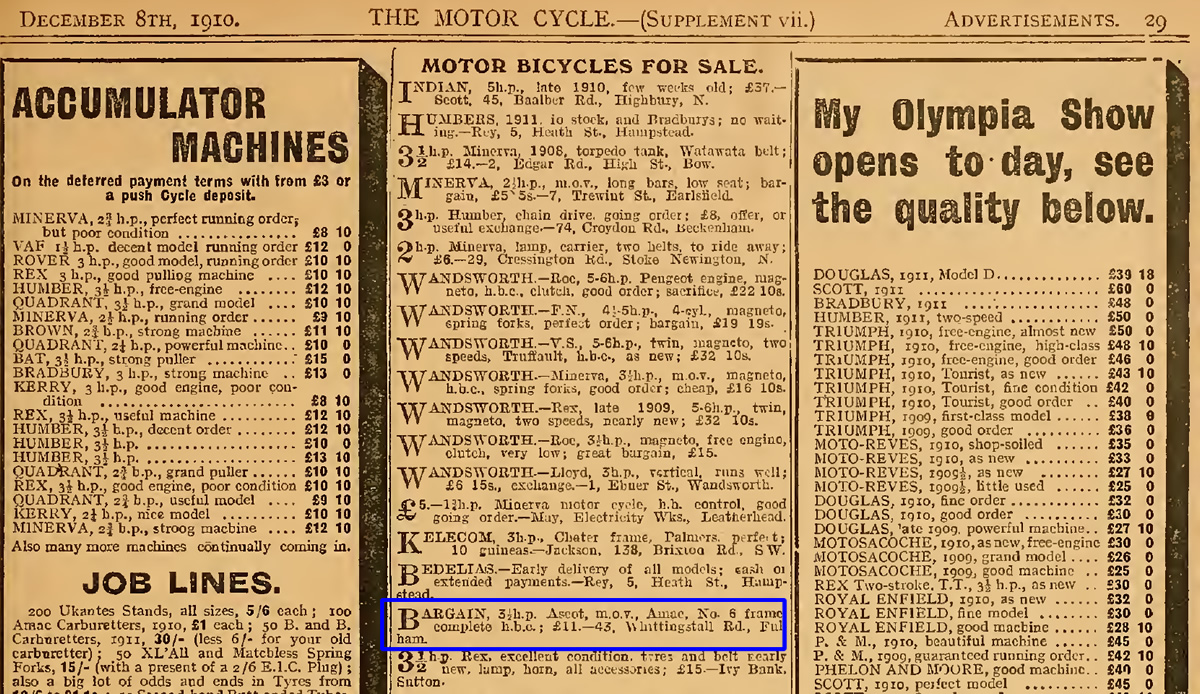
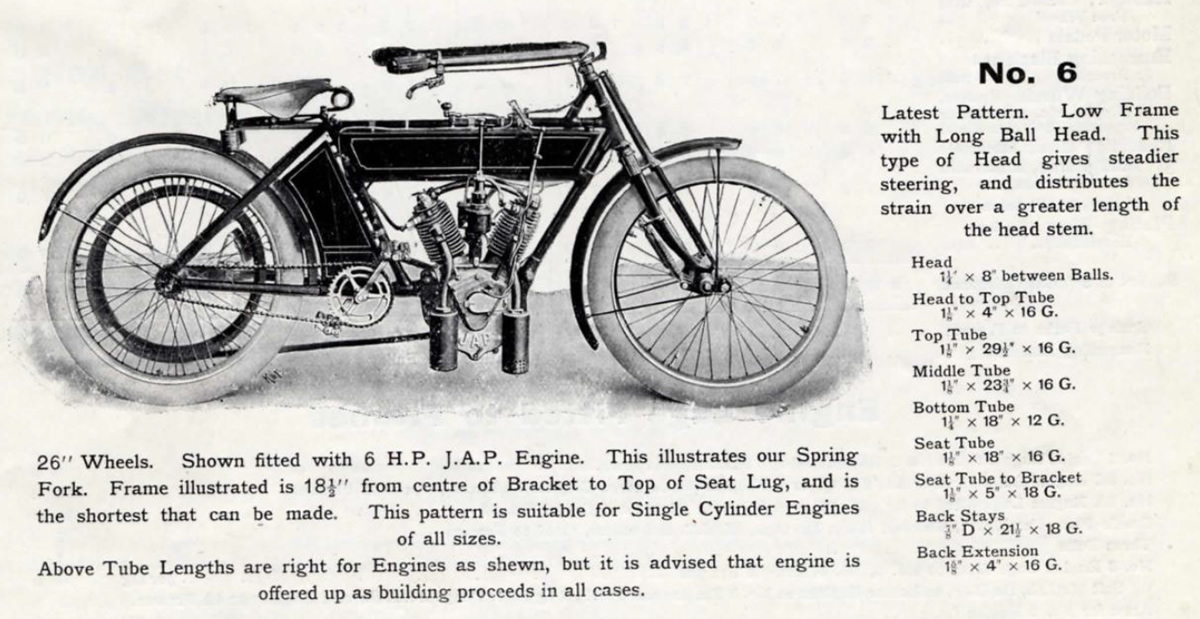
In The MotorCycle of January 1912
£15 —3 1/2hp, Ascot, magneto, tyres nearly new, low, Very fast, xxxxxx guaranteed, — 43a, Little Cadogan Place, Sloane St., S-W.
In The MotorCycle of September 19th 1912
3 1/2 h.p. Ascot, mag., practically new, £22/10—B., 47, Sandringham Rd, Willesden
In The MotorCycle of October 1912
ASCOT-CHATER, 3 1/2h.p., perfect throughout, B. am B., tyres, belt, excellent, accumulator; £9.- Langley, Pretoria Rd., Romford.
In The MotorCycle of October 9th 1913
ASCOT, 3 1/2 h.p., low built, h.b.e., B. and B. carburetter; £8.—Houlden, Winshill, Burton-on-Trent. (could be Honlden)
You can see more pictures of the Ascot engine - here
You can read my ramblings about my 1914 Triumph on my 1914 Triumph pages.